| |
 |
 |
| |
|
Lebanon |
| |
 |
 |
| |
Officially known as the Republic of Lebanon (Arabic:
al-Jumhūrīyah al-Lubnānīyah), is a country in the East Mediterranean. It is
bordered by Syria to the north and east, and Israel to the south. Lebanon's
location at the crossroads of the Mediterranean Basin and the Arabian
hinterland has dictated its rich history, and shaped a cultural identity of
religious and ethnic diversity. Capital:
Beirut.
|
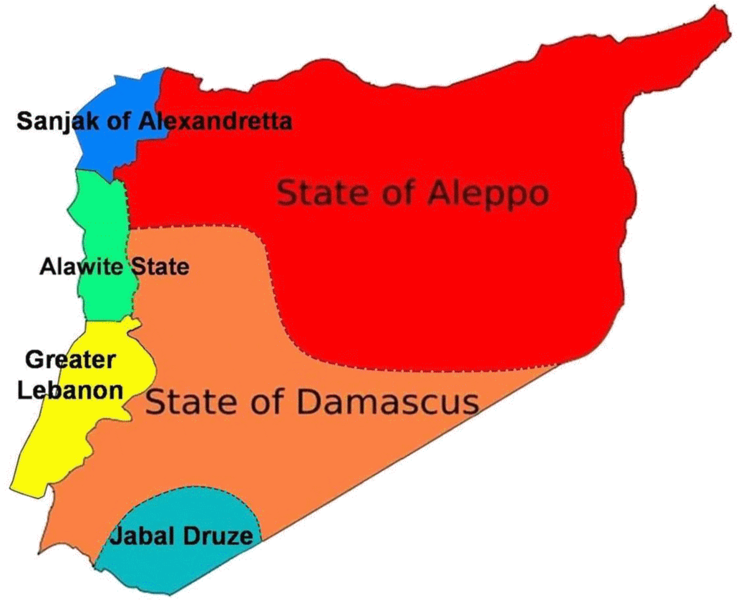 |
The earliest evidence of civilization in Lebanon dates
back more than 7,000 years—predating recorded history. Lebanon was the home of
the Phoenicians, a maritime culture that flourished for nearly 2,500 years
(3000–539 BC). Following the collapse of the Ottoman Empire after World War I,
the five provinces that comprise modern Lebanon were mandated to France. Greater
Lebanon became the current Lebanon. The French expanded the borders of Mount Lebanon, which was mostly
populated by Maronite Catholics and Druze, to include more Muslims. |
|
French-Turkish treaty settling the status of the Sanjak
was signed on 04 July 1938 and Turkish forces under Colonel Şükrü Kanatlı
entered İskenderun on July 05, 1938. On 02 September 1938, as the Second World
War loomed over Europe, the assembly proclaimed the Republic of Hatay. The
Republic lasted for one year under joint French and Turkish military
supervision. In 1939, following a popular referendum, Hatay (Sanjak of
Alexandretta) became a Turkish province. Syrian President Hashim al-Atassi
resigned in protest at continued French intervention in Syrian affairs,
maintaining that the French were obliged to refuse the annexation under the
Franco-Syrian Treaty of Independence of 1936. The remaining areas became Syria. |
|
Lebanon gained independence in 1943, and established a
unique political system, known as confessionalism, a power-sharing mechanism
based on religious communities – Bechara El Khoury who became independent
Lebanon's first President and Riad El-Solh, who became Lebanon's first prime
minister, are considered the founders of the modern Republic of Lebanon and are
national heroes for having led the country's independence. French troops
withdrew from Lebanon in 1946. Before the Lebanese Civil War (1975–1990), the
country experienced a period of relative calm and prosperity, driven by tourism,
agriculture, and banking. Because of its financial power and diversity, Lebanon
was known in its heyday as the "Switzerland of the East". It attracted large
numbers of tourists, such that the capital Beirut was referred to as "Paris of
the Middle East." At the end of the war, there were extensive efforts to revive
the economy and rebuild national infrastructure. |
Ethnic groups: Lebanese Arab
71.2%, Palestinian Arab 12.1%, Armenian 6.8%, Kurd 6.1%, other 2.6% (2000).
Religions: Muslim 55.3% (of
which Shi'a 34%, Sunni 21.3%, Isma'ilite, Alawite, Nusayri); Christian 37.6% (of
which
Catholic 25.1%[Maronite 19%, Greek Catholic or Melakite 4.6%]; Orthodox 11.7%
[Greek Orthodox 6%, Armenian Apostolic 5.2%]; Protestant 0.5%), Druze 7.1%
(1995). 17 religious sects are recognized. |
|
|
|
|
c.1800 BC - 332 BC
Location of Phoenician cities of Byblos (Jubayl), Tyre, Sidon,
and Beyryt (Beirut); subsequently ruled by the Babylonians,
Persians, Greeks, Romans, Byzantines, Crusaders, and Arabs.
1118 Emirs of the Banu Ma`n replace the (somewhat legendary)
Al Tanukh emirs.
1287 Part of Mameluke Sultanate of Egypt.
1516 Part of the Ottoman Empire.
1585 - 1590
Direct Ottoman rule.
1698 Banu Shihab replace Banu Ma`n.
27 May 1832 Annexed by Egypt (both nominally Ottoman).
10 Oct 1840 Ottoman rule restored.
16 Jan 1842 Mount Lebanon emirate ended, Ottomans divide Lebanon
administratively, creating a Christian district in the
north and an area under Druze control in the south.
16 Aug 1860 - 05 Jul 1861 Occupation by France.
09 Jun 1861 Special status of Mount Lebanon within Ottoman Empire
(autonomy revoked by Ottomans in 1915).
01 Oct 1918 Annexed by Syria.
07 Oct 1918 Occupied by France and Britain (to 24 Oct 1918).
01 Sep 1920 State of Great Lebanon (part of French Syria mandate
[headquartered in Beirut]).
01 Sep 1926 Lebanese Republic (under separated from Syrian state,
remains part of French Syria mandate).
10 Jun 1940 - 15 Jul 1941 Administration loyal to Vichy France.
(after 15 Jul 1941 Free French).
15 Jul 1941 - 31 Dec 1946 Anglo-French occupation (U.K. exits 17 Apr
1946).
26 Nov 1941 Independence from France declared (Lebanese Republic).
22 Nov 1943 Independence recognized by France.
30 Oct 1948 - 23 Mar 1949 Israeli troops occupy 13 villages in a
strip of land around
(and including) the Lebanese town of Houla.
02 Nov 1975 - 25 Apr 2005 Syrian troops garrison Lebanon.
14 Mar 1978 - 13 Jun 1978 Southern Lebanon occupied by Israel.
06 Jun 1982 - 22 May 2000 Southern Lebanon occupied by Israel.
22 Jul 2006 - 01 Oct 2006 Southern Lebanon occupied by Israel.
14 Oct 2008 Syria recognizes Lebanon's sovereignty, establishing
diplomatic relations. |
|
|
|
Territorial Disputes:
Lacking a treaty or
other documentation describing the boundary, portions of the Lebanon-Syria
boundary are unclear with several sections in dispute; since 2000, Lebanon has
claimed Shab'a Farms area in the Israeli-occupied Golan Heights; the roughly
2,000-strong UN Interim Force in Lebanon (UNIFIL) has been in place since 1978.
|
|
|
|
|
- BYBLOS (Modern Jubayl)
- An ancient port on the Lebanese coast, about 20
miles (32 km.) north of Beirut. It's name has spanned the globe from it
being the principal port through which papyrus was exported into Greece:
"Byblos" is the Greek transliteration of the term for papyrus, hence
"Bible", "bibliography", etc. A community of some sort has been located here
since at least 4000 BCE.
-
Egypt................................................c. 2000 - c. 1800
- Abichemou
I....................................................fl. 1800's
- Yapachemou Abi
I...............................................fl. 1790's
-
Rib-Hadda......................................................fl. 1700's
- Yakin
- Yantin-Ammu....................................................fl.
1500's
- Abichemou II
- Yapachemou Abi II
- Eglia
-
Egypt................................................c. 1550 - c. 1050
- Rib-Addi..................................................fl.
1300's
- Ilirabi...................................................fl.
1300's
- Unknown rulers
- Zakar
Baal.....................................................fl. 1100's
- Ahiram.........................................................fl.
1000's
- Zakar
Baal.....................................................fl. c. 1000
- Ithobaal.......................................................fl.
early 900's
- Yahimilik......................................................fl.
mid 900's
- Abi-Baal.......................................................fl.
c. 930
- Elibaal........................................................fl.
late 900's
- Tyre..............................................10th
cent. - 7th cent. ?
- Urumilki..................................................fl.
c. 740
- Sibiti
Baal...................................fl. 740's - 730's
- Milkiashapa...............................................mid
600's
- Tyre.............................................7th
cent. ? - 573
-
Babylonia................................................573 - 539
-
Persia...................................................539 - 332
- Yehawmilk.................................................fl.
450's
- Paltibaal.................................................fl.
mid 400's
- Batnoam (female)..........................................fl.
400's
- Ozbaal....................................................fl.
late 400's
- Malcander.................................................fl.
later 300's ?
- Enylus...............................................
? - 332
-
Macedon..................................................332 - 323
- Kingdom of
Antigonus.....................................323 - 301
-
Egypt....................................................301 - 198
- Seleucid
Empire..........................................198 - ?
- Cinyrus..............................................
? - 68
- Roman
Republic............................................68 - 27
- Roman
Empire..........................................27 BCE - 395 CE
- Byzantine
Empire.........................................395 - 612
-
Persia...................................................612 - 628
- Byzantine
Empire.........................................628 - 638
- Prophet Muhammad's
elected successors....................638 - 661
-
Umayyad
Caliphate........................................661 - 750
-
Abbasid
Caliphate........................................750 - 868
- Egypt (Tulunid
Dynasty)..................................868 - 905
-
Abbasid
Caliphate........................................905 - 935
- Egypt (Ikhshidid
Dynasty)................................935 - 969
- Egypt (Fatamid
Dynasty)..................................969 - 1071
- Seljuqs.................................................1071
- 1099
- Jerusalem...............................................1099 - 1109
- Lordship of GIBELET - de St. GILES
- Raymund............................................1104
- c. 1109
- Genoa...................................................1109 - 1187
- di EMBRIACO
- William
I.................................................fl. c. 1109
- Ugo
I...........................................c. 1109 - 1135
- William
II.........................................1135 - 1157
- Ugo
II.............................................1163 - 1179
- Ugo
III............................................1181 - 1186
- Guido I (1st
time).................................1186 - 1187 d. 1233
- Egypt (Ayyubid
Dynasty).................................1187 - 1196
- Genoa...................................................1196 - 1282
- Guido I (2nd
time).................................1196 - 1233
- Henry
I............................................1233 - 1252
- Bertrand
II.......................................... ? - 1258
- Henry
II...........................................1258 - 1271
- Guido
II...........................................1271 - 1282
- Tripoli.................................................1282 - 1287
- Genoa...................................................1287 - 1289
- Bartholomew........................................1287 - 1289
- Egypt, and
general Lebanese sequence, thereafter from 1289...
- Peter..............................................1289 - 1298
- ANTIOCH
- John...............................................1298 - 1300
|
|
|
|
|
- ITUREA (The Bekaa Valley)
- A region in southern Lebanon, near the current
border with Israel. The capital of the region was the city of Chalcis;
historically Chalcis was very Hellenized, even when under the rule of Jewish
kings. The Itureans were a people of uncertain origin. They were probably
Aramean in origin but may have been Canaanites or even a northern branch of
the Nabataeans. They were expert archers and were frequently incorporated as
auxiliaries in Roman armies. The region of Iturea is centered on what is
today called the Bekaa valley, a region well known for being the birthplace
of several Shi'ite terrorist groups as well as one of the most prolific
heroin-poppy production areas in the world. See also, Amurru, an important
city located in this region.
- AMURRU
- A city-state in southern Lebanon, not far from
Tyre, and located within Iturea. It was governed by an early Semitic people
whose influence was felt all over the Middle East and to which it has given
an overall name to; the Amorites.
- Abdi-Ashirta....................................................early
1300's
- Pubahla ben
Abdi-Ashirta (in Ullaza)............................early 1300's
- Aziru...........................................................early
1300's
- Duppi-Teshub....................................................1300's
- Shaushgamuwa
I.....................................fl. 1270's - 1240's
- Ben-Teshina.....................................................late 1200's
- Shaushgamuwa (II ?)
- Sacked and destroyed by the Sea Peoples
- Jetur (eponymous
ancestor king)
- ARAM-ZOBAH - An Aramean kingdom in central Syria. For a time it was the dominant Aramean
kingdom before the ascendency of Damascus.
- Unknown rulers
- Rehob...........................................................fl.
late 1000's BCE
- Hadad-ezer bar Rehob............................................fl.
early 900's
- Israel................................................c.980's - 920's
- Damascus................................................920's - 732
- Assyria...................................................732 - 612
- Babylon...................................................612 - 539
- Persia....................................................539 - 332
- Macedon...................................................332 - 323
- Menon, son
of Krydems............................fl. 330 - 320
- Kingdom of
Antigonus......................................323 - 301
- Egypt.....................................................301 - 198
- Seleucid
Empire...........................................198 - 168
- Seleucid governors of Coele-Syria
- Apollonius the Samaritan, or, of
Tarsus...........c. 180 - 175
- Apollonius Taos, son of Appolonius.........................fl.
c. 147
- Independent........................................late 160's - 105
- In 105 BCE Iturea was invaded and partially
conquered by Judah Aristobulus, the Hasmonean king of Judea. Its Hellenistic
kings probably paid tribute to Judea until the imposition of Roman rule.
- Unknown rulers
- Ptolemy Mennaeus......................................85
- 40
- Lysanias...........................................c.
40 - 36
- To Rome
thereafter...
- With direct Roman control, Augustus transferred
Chalcis into the care of the Herodian dynasty of Judea.
- Judea...............................................30's - 4
- HERODIAN
- Philip.............................................4 BCE - 34 CE
- To Rome
directly...........................................34 - 41
- Herod
II..............................................41 - 48
- Rome
directly..............................................48 - 50
- Herod Agrippa II (in
Batanaea 52-c. 100)..............50 - 52 d. c. 100
- Aristobulus
III.......................................52 - 92
- Unknown rulers
- Roman
Empire..................................c. 2nd cent. CE - 395
- Byzantine
Empire..........................................395 - 638
- Prophet Muhammad's
elected successors.....................638 - 661
-
Umayyad
Caliphate.........................................661 - 750
-
Abbasid
Caliphate.........................................750 - 868
- Egypt (Tulunid
Dynasty)...................................868 - 905
-
Abbasid
Caliphate.........................................905 - 935
- Egypt (Ikhshidid
Dynasty).................................935 - 969
- Egypt (Fatamid
Dynasty)...................................969 - 1071
- Seljuqs..................................................1071
- 1124
- Jerusalem................................................1124 - 1244
- Tripoli..................................................1244 - 1292
- Egypt (Bahri Mamluq).....................................1292
- 1390
- Egypt (Burji Mamluq).....................................1390
- 1516
-
Ottoman
Empire...........................................1516 - 1918
- In the 18th century, the area around Baalbek was
occupied by the Metawali, a sect that probably migrated to the Levant from
Persia - they are basically Shi'ite, but their worship practices include
pilgrimage to the ruins of a temple honouring Ishtar (Ashtaroth) at Apheca
where they address vows to the Sayyidat al-Kabirah, ("the Great Lady"); as
such, they are sometimes accused by more orthodox Muslims of heresy. For
almost a hundred years Ottoman jurisdiction was purely nominal, and the
Metawali ruled a virtually independent enclave from which they warred
against neighboring Maronite, Druze, and Sunni tribes. They remain today,
both in the Bekaa and also in northern Lebanon, around Kesrawan and Batroun.
- general
Lebanese sequence, thereafter from 1918
- Although this region retains international
recognition as a part of the Lebanese state, day-to-day authority has been
in the hands of non-Lebanese military and paramilitary factions, notably
Hesbollah and elements of the Syrian Army, since the 1970's.
|
|
|
|
|
- LIBAN "Lebanon proper"
- It consisting of the Lebanon mountain range in the
center of the country. Historically this has been the center of Maronite
Christian dominance in the country.
- KUNDI AND SIZU -
A pair of city-states ruled as a single kingdom,
located in the Lebanon Mountain range. The populace were probably Arameans.
- Unknown rulers
- Sanduarri..........................................late
700's - 680
-
Assyria...................................................680 - 612 BCE
-
Babylon...................................................612 - 539
-
Persia....................................................539 - 332
-
Macedon...................................................332 - 323
- Kingdom of
Antigonus......................................323 - 301
-
Egypt.....................................................301 - 198
- Seleucid
Empire...........................................198 - 68
- Silas the Jew
(Tyrant of Lysias)...........................68 - 63
- Roman
Republic.............................................63 - 27
- Roman
Empire...........................................27 BCE - 395 CE
- Byzantine
Empire..........................................395 - 612
-
Persia....................................................612 - 628
- MARADA STATES (628-1305).
- With the Muslim conquest of the Levant, an island
of Christian dominance was maintained around Mt. Lebanon and the surrounding
mountains. Ruled by a Maronite Christian, Syriac Aramaic-speaking warrior
elite called the Mardaites, the tiny Marada states survived for almost six
hundred years. Though the Mardaites had no king per se, they all
acknowledged the supremacy of the Maronite patriarch. As an interesting
aside, it should be noted that Mardaite communities existed elsewhere in the
Levant, and that in the late 600's Justinian II relocated a large number of
these as part of a peace treaty with the Caliphate. One of the relocated "Isaurians",
as they were called, would eventually become Emperor Leo III the Isaurian.
- Egypt (Burji
Mamluq).....................................1305
- 1516
-
Ottoman
Empire...........................................1516 - 1918
- In 1861 Mount Lebanon was granted special status
as an autonomous province jointly governed by the Maronites and their Druze
neighbors.
- Governors of Mount Lebanon
- Davud
Pasha.........................................1861 - 1868 d. 1873
- Franko
Pasha........................................1868 - 1873
- Rustem
Pasha........................................1873 - 1883 d. 1885
- Vasa
Pasha..........................................1883 - 1892
- Naum
Pasha..........................................1892 - 1902 d. 1911
- Muzaffar
Pasha......................................1902 - 1907
- Yusuf
Pasha.........................................1907 - 1912
- Yohannes Kuyumjian
Pasha............................1912 - 1915
- Ali Munif Bey.......................................1915
- 1916
- Ismail Haqqi........................................1916
- 1918
- Mumtaz Bey.................................................1918
- Omar al-Dauk...............................................1918
- Syria............................................01
Oct 1918 - 01 Sep 1920
- France...........................................01
Sep 1920 - 22 Nov 1943
- The French gave the Maronites of Lebanon a choice
between a small nation consisting primarily of Maronite-majority areas or a
"greater Lebanon" comprising regions where Sunnis, Shi'ites and Druze were
dominant. The Maronite leaders opted for the latter choice, leading to the
rampant "armed diversity" that characterizes Lebanon today.
- general
Lebanese sequence, thereafter from 1943.
|
|
|
|
|
- MARONITE
PATRIARCHS
- The Maronites are a Christian community of the
Levant. Their liturgy is of the Antiochene type, but conducted in Syriac.
Their head has always resided in Lebanon, though he bears the title
"Patriarch of Antioch and the East". The Maronites trace their beginnings to
St. Maron, a 5th-century monk, but did not officially become a distinct
religious community until the 7th century, when they adopted the doctrine of
Monotheletism (that Jesus had one will, despite having both human and divine
natures). During the crusades the Maronites recognized the supremacy of the
Pope and are currently in communion with the Roman Catholic church. As in
other Eastern Catholic rites, the parish priests are usually married. The
Maronite Patriarchs exerted enormous secular power over the Christians of
Lebanon, particularly during the period of the Marada States (see Liban). In
the 19th cent., massacres of Maronites by the Druze brought French
intervention; this gave France its modern hold in Lebanon and Syria. Besides
the Maronites there are two other groups in Syria in communion with the pope
- the Melkites and the Syrian Catholics.
- Patriarchs
during the Marada State (676-1099)
- John Maron I
Agathonides (1st
Maronite Patr. of Antioch)..676
- 707
- 63rd after Saint Peter.
First of the Maronite patriarchs. He was born in 628.
- Cyr (Kyros)...............................................707
- ?
- Son of Saint Maron's
sister.
- Gabriel I
- Last patriarch to reside in Kfarhi monastery.
- John Maron
II...................................................mid 700's
- Gregory I (Gregorius
I)
- Stephan (Stephanos I)
- Mark
- Eusebius (Hoaushab)
- John I
- Joshua I (Yeshu I)
- David (Daoud I)
- Theofelix (Theophilactus)
- Also known as John II Habib
- Joshua II (Yeshu II)
of Damascus
- Dumith (Domitius) of
Beirut
- Isaac (Ishaq)...................................................mid
1000's
- John III (Youhanna
III).........................................late 1000's
- Simon I (Sham'un I or
Semaan)...................................late 1000's
- Urmia I (Jeremiah I)
- John IV (Youhanna IV)
- Sham'un II (Simon II)
- Sham'un III (Simon
III)
- Gregory
II................................................. ? - 1110
- Patriarchs
during the Crusades (1099–1305)
- Joseph al-Gergessi [Youssif
al Jirjissi].................1110 - 1120
- Joseph was the first Patriarch to enter into
communion with Rome. He also was first to contact with the Crusaders.
- Peter I (Butros
I).......................................1121 - 1130
- Patriarcate moves to Mayfuq, Jbeil.
- Gregory III of Halate....................................1130
- 1141
- Jacob I (Yaqub I) of
Ramate..............................1141 - 1151
- John V of Lehfed.........................................1151
- 1154
- Peter
II.................................................1154 - 1173
- Peter III of Lehfed......................................1173
- 1199
- Urmia II (Jeremiah II)
of Amshit.........................1199 - 1230
- Daniel I of Shamat.......................................1230
- 1239
- John VI of Jaje..........................................1239
- 1245
- Simon IV (Sham'un IV)
of Bilaouza Jibbet.................1245 - 1277
- Jacob II (Yaqub
II)......................................1277 - 1278
- Daniel II of Hadchit.....................................1278
- 1282
- Luqa I of Benahran..............................................1282
- Urmia III (Jeremiah
III) of Demalsa......................1282 - 1297
- Patriarchs
during the Mumluks (1305-1516)
- Sham'un V (Simon
V)......................................1297 - 1339
- John VII of Aqura........................................1339
- 1357
- Gabriel II of
Hjula......................................1357 - 1367
- Daoud
II.................................................1367 - 1404
- John VII of Jaje.........................................1404
- 1445
- Jacob III of Hadeth......................................1445
- 1468
- Joseph II of Hadeth......................................1468
- 1492
- Patriarchs
during the Ottomans (1516-1918)
- Semaan of Hadeth.........................................1492
- 1524
- Mousa Saaed el-Akari
of Barida/Kafroun...................1524 - 1567
- Michael (Mikhail)
Rizzi of Bkoufan.......................1567 - 1581
- Sarkis el-Rizzi of
Bkoufan...............................1581 - 1597
- Joseph III el-Rizzi of
Bkoufan...........................1597 - 1608
- John IX Maklouf of
Ehden................................ 1608 - 1633
- Gewargios (George)
Omaira of Ehden.......................1633 - 1644
- Joseph IV Halib of
Aqoura................................1644 - 1648
- John X Bawab Safrawy
of Safra............................1648 - 23 Dec 1656
- George II (Jirjis)
Rizqallah of Beseb'el..........01 Jan 1657 - 12 Apr 1670
- He was son of Hadj
Rizqallah. After the death of Patriarch Safrawy happened on December 23,
1656, the bishops elected as patriarch the monk George Habquq, who anyway
for humility refused and escaped in a cave of the Kadisha Valley to live as
an hermit. So a second election was held and on January 1, 1657 the
Archbishop George Beseb'ely was elected patriarch. His election was
confirmed by Pope Alexander VII on May 26, 1659, and he received the pallium
on August 30, 1660.
- Estephen II Boutros El
Douaihy of Ehden...........20 May 1670 - 03 May 1704
- Almost immediately after
his death, he was considered by many Maronites of Lebanon, but particularly
in North Lebanon in Zgharta and Ehden to have been a saint.
- Gabriel of Blaouza................................12
May 1704 - 31 Oct 1705
- Jacob IV Awad of
Hasroun..........................06 Nov 1705 - 12 Feb 1733
- The election of Jacob Awad
as patriarch was opposed by a number of bishops, who in the next years built
a fierce opposition to him, spreading rumors about inadmissible behaviors of
the Patriarch in his residence of Qannubin Monastery. These rumors turned
into a large scandal, and finally the bishops, advised by some Latin
missionaries, in particular by the Carmelite Elias Giacinto, sent for Jacob
Awad and summoned a brief trial in the church of Saint Serge and Bacchus in
Rayfoun. Here, on May 1710, Jacob Awad was declared guilty and deposed. In
his place it was elected patriarch the bishop of Saida, Youssef Moubarak Al
Rayfouni and Awad was confined in the monastery of Our Lady of Louiaze.
However, to fully enforce the decisions taken, it was necessary to obtain
the approval of Pope: with this aim the opponents of Awad sent to Rome
Georges Benjamin bishop of Ehden. In Rome, contrary to Benjamin's hopes, the
Congregation for the Propagation of the Faith on December 16, 1710 ruled in
favor of Awad.
- Joseph V Dergham
Khazen of Ghosta.................25 Feb 1733 - 13 May 1742
- The reign of Joseph Dergham
El Khazen is remembered for the 1736 Maronite Synod of Mount-Lebanon, which
laid the foundations for the modern Maronite Church. At the death of
Patriarch Joseph Khazen, who died on May 13, 1742, the bishops who attended
the funeral met and elected Simon Awad as Patriarch, but Simon refused for
humility. The bishops so elected the bishop of Arka, Elias Mohasseb. Bishops
Tobias El Khazen and Ignace Chrabai were absent from the meeting, perhaps
not invited, and opposed the election of Elias. These two bishops ordained
two new bishops and held a new election among themselves, electing Tobias El
Khazen as Patriarch and splitting the Church. To keep the Church united, the
Pope Benedict XIV took the extraordinary initiative to deal directly into
the affairs of the Maronite Church, and on March 16, 1743 he choose Simon
Awad in place of the two pretenders.
- Simon VII Awad of
Hasroun.........................16 Mar 1743 - 12 Feb 1756
- Tobias (Tubiya) El
Khazen of Bekaata Kanaan.......28 Feb 1756 - 29 May 1766
- Joseph VI Estephan of
Ghosta......................09 Jun 1766 - 22 Apr 1793
- Michael Fadel of
Beirut...........................10 Sep 1793 - 17 May 1795
- Philip Gemayel of
Bikfaya.........................14 Jun 1795 - 12 Apr 1796
- Joseph VII Peter Tyan
of Beirut...................28 Apr 1796 - 24 Sep 1808
- John XI Helou of
Ghosta...........................08 Jun 1809 - 12 May 1823
- After the turbulent years
in which the previous Patriarch Joseph Tyan supported Napoleon in the Siege
of Acre (1799) and came in conflict with the emir Bashir II, Patriarch John
Helou chose a low and neutral course of action, and from 1811 he retreated
in the Qannubin Monastery, the ancient and abandoned patriarchal residence,
located in the deep gorge of Kadisha Valley, which he restored.
- Joseph VIII (Youssef)
Peter Hobaish of SahelAlma..25 May 1823 - 23 May 1845
- Joseph IX (Youssef)
Ragi El Khazen of Ajaltoun....18 Aug 1845 - 03 Nov 1854
- Paul I Peter (Boulos
Boutros) Massad of Ashkout...12 Nov 1854 - 18 Apr 1890
- John XII Peter Hanna
El Hajj of Dlebta............28 Apr 1890 - 24 Dec 1898
- Patriarchs
after World War I
- Elias Peter Hoayek of
Hilta.......................06 Jan 1899 - 24 Dec 1931
- Anthony II Peter Arida
of Bsharri.................08 Jan 1932 - 19 May 1955
- Paul II Peter (Boulos
Boutros) Meoushi of Jezzine.25 May 1955 - 11 Jan 1975
- Anthony III Peter
Khoraish of Ain Ibl.............03 Feb 1975 - 03 Apr 1986
- On April 03, 1986, he
resigned as Maronite Patriarch of Antioch. He died on August 19, 1994 in
Beirut and was buried at the see of the Maronite Catholic Patriarchate in
Bkerké, Lebanon.
- Nasrallah Boutros
Sfeir of Reyfoun................19 Apr 1986 - 26 Feb 2011
- He was elected to the
primacy of the Maronite Church by the Council of Maronite Bishops, on April
19, 1986, and he was confirmed by Pope John Paul II on May 07, 1986. He was
elected Patriarch of Antioch for the Maronites on April 27, 1986, and his
resignation was accepted on February 26, 2011. He is the third Maronite
Cardinal and he was the 76th Patriarch of the Maronite Church with the
official title of "His Beatitude and Eminence the seventy-sixth Patriarch of
Antioch and the Whole Levant".
- Bechara Boutros al-Rahi
of Himlaya................15 Mar 2011 - date
|
|
|
|
|
- SIDON
- The oldest and, for a time, most powerful of
Phoenician cities. Located equidistant between Tyre (Sur) to the south and
modern Beirut to the north, it still exists as a bustling Mediterranean
seaport under the name of Saydah.
- Zimrida.........................................................18th
cent.
- Unknown rulers
- Zimr-Hadda (Zimrida
II).........................................1300's BCE
- Iab-nilu........................................................1300's
- Unknown rulers
- Tyre...............................................10th
cent. - 7th cent. ?
- Ethbaal (Etzel-Baal).................................940
- 908
- Ethbaal was the father of Jezebel (Eyezevel),
who married King Ahab of Israel.
- Unknown rulers
- Tubaal.....................................................fl.
c. 740
- Luli..........................................late
700's - early 600's
- Luli may be
identical to Elulaios, King of Tyre......729 - 694.
- Abd Melkarth....................................................early
600's
- Abdimilkutte (same as
above ?)..................................fl. 660's
- Tyre..............................................7th
cent. ? - 573
-
Babylon...................................................573 - 539
-
Persia....................................................539 - 332
- Eshmunazzar I
- Tabnit
I...................................................fl. early 400's
- Amastoreth (Anysus)........................................fl.
c. 480's
- Eshmunazzar II
- Tetramnestus
- Ba'al Sillem
II......................................407 - 374
- Bodastart I Strato................................c.
374 - 363
- Tabnit II (Tennes)...................................363
- 358
- In 358, Tabnit II raised the standard of
rebellion in Sidon, but was crushed by Persia later the same year. The
city was razed, and had to be rebuilt.
- Bodastart II
- Yaton Melik
- Abdiashirta................................................fl.
mid 300's
- Unknown rulers
-
Macedon...................................................332 - 323
- Abdalonymous (also in Tyre)..........................332
- ?
- Kingdom of
Antigonus......................................323 - 301
- Philoclos.........................................c.
312 - c. 310
-
Egypt.....................................................301 - 198
- Seleucid
Empire...........................................198 - c. 112
- Aristocratic
Republic..................................c. 112 - 68
- Roman
Republic.............................................68 - 27
- Roman
Empire...........................................27 BCE - 395 CE
- Byzantine
Empire..........................................395 - 612
-
Persia....................................................612 - 628
- Byzantine
Empire..........................................628 - 638
- Prophet Muhammad's
elected successors.....................638 - 661
-
Umayyad
Caliphate.........................................661 - 750
-
Abbasid
Caliphate.........................................750 - 868
- Egypt (Tulunid
Dynasty)...................................868 - 905
-
Abbasid
Caliphate.........................................905 - 935
- Egypt (Ikhshidid
Dynasty).................................935 - 969
- Egypt (Fatamid
Dynasty)...................................969 - 1110
- Jerusalem................................................1110 - 1244
- Lordship of Sagette
- GRENIER
- Eustace
I...........................................1110 - 1124
- Eustace
II..........................................1124 - c. 1131
- Gerard...........................................c. 1131 - 1164
- To Jerusalem directly (1164-c. 1171)
- BOFOR
- Reynald..........................................c.
1171 - c. 1187
- Egypt (Ayyubid
Dynasty)..................................1187 - 1229
- Jerusalem................................................1229 - 1244
- d'IBELIN
- Balian (Lord
of Beirut & Nablus)....................1229 - 1247
- Tripoli..................................................1244 - 1292
- GRENIER
- Julian..............................................1247 - 1260
- Balian
II...........................................1260 - 1291
- Eustace III ?
......................................1291 - 1292
- Egypt (Bahri Mamluq).....................................1292
- 1390
- Egypt (Burji Mamluq).....................................1390
- 1516
-
Ottoman
Empire...........................................1516 - 1918
- Under the control of the Emirs of Lebanon (see
Tripoli below), 1660-1772
- Ottoman Walis in Sa`ida (Sidon) and Acre
(Akko)
- Umar az-Zahir ibn Umar az-Zaydani...................1772
- 1775
- Ahmad Pasha the
Butcher (al-Djazzar)................1775 - 1804
- Süleyman
Pasha......................................1804 – 1809
- Ismail..............................................1809 – 1820
- Abdullah
Pasha......................................1820 - 1831
- Egypt (Muhammad Ali
- Khedivate Dynasty)..........27 May 1832 - 10 Oct 1840
-
Ottoman
Empire....................................10 Oct 1840 - 1918
-
Köse Ahmed Zekeriya Pasha.......................Nov 1840 - Mar 1841
-
Eneste/Haseki Mehmed Selim Pasha................Mar 1841 - Dec 1841
- Mehmed Izzet
Pasha..............................Dec 1841 - Jul 1841
- Mustapha
Pasha.............................................1842
- Selim Pasha................................................1842
- Ömer Pasha (Mihaylo Lattas).........................1842
- 07 Dec 1842
- Ayasli Asad Mehmed
Muhlis Pasha.................Aug 1842 - 09 Apr 1845
- Yozgatli Mehmed Vecihi
Pasha.................09 Apr 1845 – Jan 1846
-
Mühendis Mehmed
Kamil
Pasha.....................Jan 1846 - Sep 1847
-
Mustafa Sherifi Pasha...........................Sep 1847 - Jul 1848
-
Serhalifizade Vamik (Femiq) Salih
Pasha (1st)...Aug 1848 -
Sep 1851
-
Pepe Mehmed Emin Pasha
.........................Sep 1851 – Sep 1852
-
Serhalifizade Vamik (Femiq) Salih
Pasha (2nd)...Sep 1852 –
Mar 1855
- Mahmud
Nedim Pasha..............................Mar 1855 - Dec 1855
-
Serhalifizade Vamik (Femiq) Salih
Pasha (3rd)...Dec
1855 - Jun 1857
-
Arnavud Mehmed
Kurshid
Pasha....................Jun 1857 – 17 Jul 1860
- Fuad
Pasha...................................17 Jul 1860 - 09 Jun 1861 and...
- Charles-Marie-Napoléon
de Beaufort d'Hautpoul.16 Aug 1860 - 05 Jul 1861 d. 1890
- He was a French
Commander. He is especially known for leading in 1860, the French
expedition in Syria in the Ottoman territory, with the agreement of the
Ottoman Empire, with the objective to fulfill its mission to protect
Christians in the Middle-East, following massacres of Maronite
Christians.
- Kaysarli Ahmad
Pasha............................Aug 1861 – Feb 1863
- Mehmed Kabuli
Pasha.............................Feb 1863 - Feb 1864 d. 1877
- Mehmed Kurshid
Pasha............................Feb 1864 – Apr 1865
- Within Vilayet of Beirut thereafter...
- Syria............................................01
Oct 1918 - 01 Sep 1920
- France...........................................01
Sep 1920 - 22 Nov 1943
- Lebanon sequence afterwards...
|
|
|
|
|
- TORON
(Tibneen)
- A town in southern Lebanon, 49 miles (79 km.)
south of Beirut, 14 miles (22 km.) east of Tyre, and 10 miles (16 km.) west
of Qiryat Shemona, in Israel. The castle of Toron was built by Hugh of St.
Omer, Prince of Galilee, to help capture Tyre. After Hugh's death it was
made an independent seigneury, given to Humphrey I in 1107. The lords of
Toron tended to be very influential in the kingdom; Humphrey II was
constable of Jerusalem and Humphrey IV was married to Isabella, Amalric I's
daughter (Toron passed under royal control during their marriage). It was
also one of the few to have a hereditary lordship, at least for a few
decades. The lords of Toron were also connected to the Lordship of
Outrejordain. Toron was later merged with the royal domain of Tyre. Toron
had two vassals of its own, the Lordship of Castel Neuf and the Lordship of
Toron Ahmud. Castel Neuf was built by Hugh of St. Omer around 1105 but was
later given to the Hospitallers, until it fell to Nur ad-Din in 1167. Toron
Ahmud remained in the Lordship of Beirut until John of Ibelin sold it to the
Teutonic Knights in 1261.
- Kingdom of
Jerusalem.....................................1100 - 1187
- de FAQUEMBERG
- Hugh of St. Omer
(Pr. of Galilee)..................... ? - 1107
- de TORON
- Humphrey
I..........................................1107 - 1136
- Humphrey
II.........................................1136 - 1178 with...
- Humphrey
III.....................................c. 1160 - c. 1170
- Humphrey
IV......................................c. 1179 - 1183 d. 1192 ?
- Royal
domain........................................1183 - 1187
-
Egypt (Ayyubid Dynasty)..................................1187 - 1229
- Toron was dismantled by Sultan al-Muazzam in 1219
along with the defenses of Jerusalem and the castles of Safed and Banyas.
This was done in case it was necessary to exchange these for Damietta on the
Nile Delta, which had been captured by the forces of the Fifth Crusade who
were now threatening Cairo. Al-Mu'azzam was not prepared to give strong
defendable cities to the Crusaders if he could avoid it. Although the
exchange proved unnecessary, al-Mu'azzam's caution was justified. In 1229,
just two years after al-Mu'azzam's death on November 11, 1227, Frederick II
recovered Toron in a treaty with Sultan al-Kamil. Frederick then had the
fortifications of Toron and Montfort rebuilt.
- Kingdom of
Jerusalem.....................................1229 - 1283
- de MONTFORT
- Philip (and
Lord of Tyre)...........................1229
- 1270
- John (and
Lord of Tyre).............................1270
- 1283
- Egypt (Bahri Mamluq).....................................1283
- 1390
- Egypt (Burji Mamluq).....................................1390
- 1517
-
Ottoman
Empire...........................................1517 - 1917
- Great
Britain............................................1917 - 1918
- Syria............................................01
Oct 1918 - 01 Sep 1920
- France...........................................01
Sep 1920 - 22 Nov 1943
- Lebanon sequence afterwards...
|
|
|
|
|
- TRIPOLI (Arabic Tarabulus, Phoen. Athar?)
- An important seaport located
in northern Lebanon; a County during Crusader times. In it's origins,
Tripoli consisted of three cities (founded as colonies of Sidon, Tyre, and
Arvad), each a Greek stadia's distance from each other. The city was the
center of a loose federation between these three dominant Phoenician states.
- 1400–1200 BC: Recent discovery of pottery
fragments: evidence of late Bronze Age settlement. Historical written
records mention the settlement of the Had'teen Tribe (Cana'anian) after
migrating from Palestine (13th BC); later on they were known as Tripolitans.
Greeks named the Cana'anians 'the Phoenicians.'
- 14th–8th century BC: Phoenician trading station.
Later on, Phoenicians started sailing to shores of Northern Africa and South
Europe and establishing cities in many Mediterranean localities.
- Founded c. 700
- Joint rule by Sidon, Tyre, and Arvad..................c. 700 - 539
BCE
- Persia...................................................539 - 332
- Phoenicia became a province of the Persian Empire.
- 351 BC: Full independence proclaimed by Phoenician
states from the Persian Empire.
- 358 BC: Triple city coalesced into one entity;
became the center of Phoenician confederation and neutral meeting ground for
the governors of the three main Phoenician cities/seaports: Aradus (modern
Ruad in Syria), Sidon, and Tyre.
- Macedon..................................................332 - 323
- 333 BCE: Alexander the
Great in Phoenicia following victory over Persian king at Issus, arsenals of
Tripolis harbor burned down. In 323 BCE, Alexander's death and
break-up of his empire into three parts: Macedon, Egypt (ruled by the
Ptolemies), and the Seleucid Empire. Struggle between the Ptolemies of Egypt
and the Seleucid kings of Antioch; Tripolis passed back and forth between
the two powers.
- Kingdom of Antigonus.....................................323 - 301
- Egypt....................................................301 - 198
- Seleucid Empire..........................................198 - ?
- Dionysius (as tyrant ?)................................... ? - 68
- Roman Republic............................................68 - 27
- In 64 BCE, Phoenicia and
the rest of Syria became a Roman province; Tripoli, Tyre and Sidon granted
privileges of self-government (secondary role of Tripolis compared to Beirut
and Sidon); Roman general Pompey beheaded Dionysius, the ruler of Tripolis,
judged as tyrant. In 37–36 BCE, Tripolis is a part of the donations by Marc
Antony to Cleopatra.
- Roman Empire..........................................27 BCE - 395 CE
- In 117–138, under Emperor
Hadrian, Tripolis was granted the right of asylum and assigned a naval
command; it became an important religious center with a temple for imperial
cult; from numismatic evidence it must have had temples dedicated to
Astarte, the Dioscuri and Zeus Haghios.
- Byzantine Empire.........................................395 - 638
- Prophet Muhammad's
elected successors....................638 - 661
- In 645/646, Muslim army
laid siege to Tripoli. General Sufyan built a fort on Abu Samra hilltop to
survey the city; population fled to Cyprus; Tripoli captured and resettled
with Persians and Jewish population. From 646–1070, Tripoli subject to
Byzantine incursions during the Ummayad, Abassid and Fatimid rule aimed at
the control of the coastal road.
-
Umayyad
Caliphate........................................661 - 750
-
Abbasid
Caliphate........................................750 - 868
- Egypt (Tulunid
Dynasty)..................................868 - 905
-
Abbasid
Caliphate........................................905 - 935
- Egypt (Ikhshidid
Dynasty)................................935 - 969
- Egypt (Fatamid
Dynasty)..................................969 - 1070
- Seljuqs.................................................1070 - 1101
- From 1070–1109, Tripoli
politically independent from the Fatimids under the Banu Ammar emirs, who
built the famous Dar Al-Ilm (a library that contained around 3,000,000
manuscripts).
BANU 'AMMAR
- Amin ud-Dawlah Hassan..............................1070 - 1072
- Djalal ul-Malik Ali................................1072 - 1099
- Fakhr ul-Mulk......................................1099 - 1109 opposed by...
- Principality of Tripoli
- TOULOUSE
- Raymond I (Count of Toulouse 1088-1105).................1101 - 1105
- 1099 beginning of a ten
years siege of Tripoli by Raymond of Saint-Gilles, Count of Toulouse (d.
1105 prior to the ending of the siege). Beginning of the construction of the
Citadel in 1103. Fall of Tripoli to the Crusaders and its rebuilding over
Muslim town in 1109.
- Alphonse-Jordan.........................................1105 - 1109
- William-Jordan (regent)............................1105 - 1109
- Bertrand................................................1109 - 1112
- Pons....................................................1112 - 1137
- Raymond II..............................................1137 - 1152
- Raymond III (Prince of Galilee as well).................1152 - 1187
- CHATILLON
- Bohemond IV (in Antioch 1163-1201)......................1187 - 1233
- Bohemond V..............................................1233 - 1251
- Bohemond VI (in Antioch 1251-1268)......................1251 - 1275
- In 1268, the castle and the
Crusaders burg occupied and destroyed by Baibars.
- Bohemond VII............................................1275 - 1287
- Sybilla (female)...............................................1287
- Republic (commune)......................................1287 - 1288
- Lucia (female)..........................................1288 - 1289
- In 1289, Fall of Crusader
Tripoli (harbor city: El Mina) to Sultan al-Mansur Qalawun; city site
transferred inland at the foot of Mount Peregrinus (Abu Samra) for
protection against the return of the knights still on Cyprus and Rhodes;
Arab Tripoli or medina built around inland citadel (the castle of
saint-Gilles) over Crusader bourg and along the banks of Qadisha River (Abu
Ali).
- Egypt (Bahri Mamluq)....................................1289
- 1390
- Egypt (Burji Mamluq)....................................1390
- 1412
- MA'ANID
- Ali
- Bashir I
- Muhammad
- Sa'ad ad-Din..........................................? - 1349
- Othman.............................................1349 - ?
- Nawruz al-Harzi.........................................1412 - 1414
- Egypt (Burji Mamluq)....................................1414 - 1516
- Ahmed I
- Mulhim I............................................. ? - 1480
- Yusuf II...........................................1480 - 1516
- At the end of the 15th century, the governor of
Tripoli (Lebanon) Youssef Bek Sayfa established Khan Al Saboun (the hotel of
soap traders). This market was finished at the beginning of the 16th
century, the last days of the Mamlouks ruling. The manufacture of soap was
very popular in Tripoli. There, the market became a trade center where soap
was produced and sold. Afterwards, traders of Tripoli began to export their
soap to Europe.
-
Ottoman Empire..........................................1516 - 1832
- Fakhr ad-Din I.....................................1516 - 1544
- Qurqumaz I ibn Fakhr
ad-Din I......................1544 - 1585
- To the Ottomans directly 1585-1590
- Fakhr ad-Din II ibn Qurqumaz I (1st
time)..........1590 - 1613 d. 1635
- In 1612, flood destroyed
Mamluk monuments.
- Yunus II ibn Qurqumaz I............................1613 - 1617
- Fakhr ad-Din II ibn Qurqumaz I (2nd
time)..........1617 - 1635
- In 1623, Fakhr ad-Din
attacked the forces of Pasha of Tripoli at Anjar; Tripoli fell to
Fakhr-ed-Din, (Sultan al-Barr or Sultan of the Land).
- Ali ibn
Fakhr ad-Din
I.....................................1635
- Mulhim I ibn Yunus II..............................1635 - 1657
- Ahmad ibn Mulhim I.................................1657 - 1697 with...
- Qurqumaz II........................................1658 - 1665
- SHIHABID
Sunni Muslims until Yusuf III, Maronite Christians thereafter.
- Bashir I ibn al-Husayn.............................1697 - 1706
- Haidar I ibn Musa..................................1706 - 1732
- Mulhim II ibn Haidar I.............................1732 - 1754
- al-Mansur ibn Haidar I.............................1754 - 1770
with...
- Ahmad ibn Haidar I.................................1758
- 1770 with...
-
al-Qasim ibn Umar (in
rebellion)..........................1760
- Yusuf III ibn Mulhim II (1st
time).................1770 - 1778 d. 1790
- Ahmad IV ibn Mulhim II.............................1778 - 1780 with...
- Afandi ibn Mulhim II...............................1778 - 1780
- Yusuf III ibn Mulhim II (2nd
time).................1780 - 1789
- Bashir II ibn
al-Qasim
(1st
time)..................1789 - 1790 d. 1840
- Yusuf III ibn Mulhim II (3rd
time)........................1790
- Bashir II ibn
al-Qasim
(2nd
time).........................1790
- Haidar II ibn Mulhim II............................1790 - 1793 with...
- Qaädan ibn Muhammad (1st
time).....................1790 - 1793
- al-Husein ibn Yusuf (1st
time)............................1793 with...
- Salim ibn Yusuf (1st
time)................................1793 and...
- Saäd ad-Din ibn Yusuf (1st
time)..........................1793 d. c. 1800
- Bashir II ibn
al-Qasim
(3rd
time)..................1793 - 1795
- al-Husein ibn Yusuf (2nd
time)............................1795 with...
- Salim ibn Yusuf (2nd
time)................................1795 and...
- Saäd ad-Din ibn Yusuf (2nd
time)..........................1795
- Bashir II ibn
al-Qasim
(4th
time)..................1795 - 1799
- al-Husein ibn Yusuf (3rd
time).....................1799 - 1800 with...
- Salim ibn Yusuf (3rd
time).........................1799 - 1800 and...
- Saäd ad-Din ibn Yusuf (3rd
time)...................1799 - 1800
- Bashir II ibn
al-Qasim
(5th
time)..................1800 - 1801
- al-Abbas ibn Asaad (1st
time).............................1801 d. c. 1822
- Qaädan ibn Muhammad (2nd
time)............................1801 with...
- Salman ibn Ahmad (1st
time)...............................1801 d. c. 1822
- Bashir II ibn
al-Qasim
(6th
time)..................1801 - 1821
- al-Hasan ibn Ali (1st
time)...............................1821 with...
- Salman ibn Ahmad (2nd
time)...............................1821
- Bashir II ibn
al-Qasim
(7th
time)..................1821 - 1822
- al-Hasan ibn Ali (2nd
time)...............................1822
with...
- Salman ibn Ahmad (3rd
time)...............................1822
- al-Abbas ibn Asaad (2nd
time).............................1822
- Bashir II ibn
al-Qasim
(8th
time)..................1822 - 1840
- From 1798–1835, Mustafa
Agha Barbar ruled as governor of Tripoli on behalf of the Ottoman Empire.
- Egypt (Muhammad Ali
- Khedivate Dynasty).........27 May 1832 - 08 Oct 1840
-
Ottoman Empire...................................08
Oct 1840 - 16 Aug 1860
- Bashir III..................................08
Oct 1840 - 16 Jan 1842 d.1851
- Ottoman governors
- Mustapha Pasha............................................1842
- Omar Pasha................................................1842
- Mohammed Pasha.....................................1842 - ?
- Assad Pasha.......................................... ? - 1845
- Wahaji Pasha.......................................1845 - 1847
- Wamiq Pasha Amin...................................1847 - ?
- Ahmad Pasha
- Kurshid Pasha........................................ ? - 1860
- Fuad Pasha.........................................1860 - 1861 opposing...
-
France...........................................16 Aug 1860 - 05 Jul 1861
- Charles-Marie-Napoléon
de Beaufort d'Hautpoul...16 Aug 1860 - 05 Jul 1861
-
Ottoman Empire...................................05
Jul 1861 - 1918
-
Governors (mutassarifs) of Mount Lebanon
- Daoud Efendi Pasha.............................Jun 1861 -
May 1868
- Franko Kusa Nasri Pasha........................Jun 1868 -
02 Feb 1873
- Rüstem Pasha...................................Mar 1873 -
Mar 1882
- Wassa (or Vasa) Pasha.......................09
May 1883 - 26 Jun 1892
-
Duhani Naum Nimetullah Pasha................15
Aug 1892 - 02 Aug 1902
- Muzaffar Pasha
(Wladyslaw
Czajkowski) ......27
Sep 1902 - 28 Jun 1907
- Franco Kusa Yusuf Pasha........................Jul 1907 -
Dec 1912
- Yohannes Kuyumjian Pasha....................23
Dec 1912 - Sep 1915
-
Yegenaga
Ali Münif Bey......................25
Sep 1915 - 15 May 1916
- Ismail Haqqi Bey...............................May 1916 -
Aug 1918
- Mümtaz Bey..................................15
Aug 1918 - 30 Sep 1918
- Omar al-Dauk................................30
Sep 1918 - 07 Oct 1918
- Great Britain..................................................1918
- Syria............................................01
Oct 1918 - 01 Sep 1920
- France...........................................01
Sep 1920 - 22 Nov 1943
- Lebanon sequence afterwards...
|
|
|
|
|
- TYRE
- Tyre, as the primary Phoenician port, was an
extremely important city and the primary source of the purple dye used
throughout the classical world. The seven-month siege that it took Alexander
the Great to conquer the place is also legendary.
- Ancient Tyrian rulers based on Hellenic tales.
- Agenor.........................................................c.
1500 ?
- Phoenix
- Eri-Aku (Herakles).............................................1400's
- Eri Aku may be the model for such figures as the
Greek Heracles, the Biblical Arioch king of Ellaser, and the
- Homeric Erichthonius king of Troy and Pontus.
- Abimilki.......................................................1300's
- Aribas.........................................................fl.
c. 1230
-
Baal-Termeg....................................................fl. c. 1220
-
Baal...........................................................c. 1193
- Pummay................................................c.1163
- 1125
- Unknown Rulers
- Phoenician State
- Abibaal..................................................990
- 978
- Hiram I the
Great........................................978 - 944
- Baal-Eser
I..............................................944 - 927
- Abdastratus..............................................927
- 918
- Methusastartus...........................................918
- 906
- Astarymus................................................906
- 897
- Phelles..................................................897
- 896
- Eshbaal
I................................................896 - 863
- Baal-Eser
II.............................................863 - 829
- Mattan
I.................................................829 - 820
-
Pygmalion................................................820 - 774
- Unknown Ruler 774-750.
- Eshbaal
II...............................................750 - 739
- Hiram
II.................................................739 - 730/29
- Mattan
II.............................................730/29 - 729
- Elulaios.................................................729
- 694
- Abd Melqart..............................................694
- 680
- Baal
I...................................................680 - 660
- Unknown Rulers 660-590
- Eshbaal
III............................................591/0 - 573/2
-
Babylon..................................................573 - 539
- Baal
II...........................................573/2 - 564
- Yakinbaal...........................................564
- 564/3
- In the 560's the monarchy was overthrown and a
oligarchic government established, headed by "judges" or shoftim (cf.
Carthage).
- Shoftim of Tyre
- Chelbes...........................................564/3
- 563
- Abbar...............................................563
- 562
- Mattan
(III)........................................562 - 556 with...
-
Ger-Asthari.........................................562 - 556
- Baal-Eser
III.......................................556 - 555
- Mahar-Baal..........................................555
- 551
- The monarchy was restored with the ascension
of Hiram III to the throne.
- Hiram
III...........................................551 - 532
-
Persia...................................................539 - 420
- Unknown Rulers
- Mattan
IV....................................fl. c. 490 - 480
- Unknown Rulers
- Boulomenus................................................fl.
c. 450
- Unknown Rulers
- Abdemon..........................................c.
420 - 411
- (Cypriot)
Salamis........................................411 - 374
-
Persia...................................................374 - 332
- Unknown Rulers
- Eugoras (grandson
of Salamis King)........................fl. 340's
- Azemilki Straton.................................c.
340 - 332
-
Macedon..................................................332 - 323
- Abdalonymus (also
in Sidon).........................332 - ?
- Kingdom of
Antigonus.....................................323 - 301
-
Egypt....................................................301 - 198
- Seleucid
Empire..........................................198 - c. 140
- Aristocratic
Republic.................................c. 140 - 64
- Roman
Republic............................................64 - 27
-
Marion....................................................c. 42
- Roman
Empire..........................................27 BCE - 395 CE
- Byzantine
Empire.........................................395 - 638
- Prophet Muhammad's
elected successors....................638 - 661
-
Umayyad
Caliphate........................................661 - 750
-
Abbasid
Caliphate........................................750 - 868
- Egypt (Tulunid
Dynasty)..................................868 - 905
-
Abbasid
Caliphate........................................905 - 935
- Egypt (Ikhshidid
Dynasty)................................935 - 969
- Egypt (Fatamid
Dynasty)..................................969 - 1124
- Jerusalem...............................................1124 - 1244
- MONTFERRAT
- Conrad.............................................1188 - 1192
- CHAMPAGNE
- Henry (II of
Champagne)............................1192 - 1198
- de LUSIGNAN
- Amalric (II
of Jerusalem)..........................1198 - 1205
- de MONTFORT
- Philip (and
Lord of Toron).........................1229 - 1268
- John (and
Lord of Toron)...........................1268 - 1283
- Humphrey...........................................1283 - 1284
- Margarete (female).................................1284
- c. 1291
- Roupen (titular
1291-1313).........................1284 - 1291
- Amaury (Amalric
of Lusignan; titular only).........1290 - 1310
- To Egypt (Ayyubid Dynasty) from 1244, and general Lebanese sequence
thereafter...
|
|
|
|
|
|
|
|
|
LEBANON
- This list will focus on Beirut. For other important Lebanese communities
in the region, see Sidon and Tyre and, at a much later period, Tripoli. This
list finishes with an account of the modern Lebanese State, known as Beyryt (place of wells) to the Phoenicians and Berytus to the Greeks.
Beirut was a center of trade from ancient times.
- Founded c.1600 BCE by Phoenicians of Byblos
- Independent c. 1400 BCE
- Unknown rulers
- Ammunira.......................................................c. 1300's
BCE
- Abibal.........................................................fl. c. 1250
- Unknown rulers
- Tyre.................................................c. 1000 - 609
BCE
- Egypt....................................................609 - 605
- Babylonia................................................605 - 539
- Persia...................................................539 - 332
- Macedon..................................................332 - 323
- The Kingdom of Antigonus.................................323 - 301
- Egypt....................................................301 - 198
- Seleucid Empire..........................................198 - 68
- Roman Republic............................................68 - 27
- Roman Empire..........................................27 BCE - 395 CE
- Byzantine Empire.........................................395 - 612
- On 09 July 551, Beirut city
till Tripoli were destroyed by earthquake and tsunami and rebuilt with the
help of Byzantine Emperor Justinian I. It triggered a devastating tsunami
which affected the coastal towns of Phoenicia, causing great destruction and
sinking many ships. Overall large numbers of people were reported killed,
with one estimate of 30,000 by Antoninus of Piacenza for Beirut alone.
- Persia...................................................612 - 628
- Byzantine Empire.........................................628 - 638
- Prophet Muhammad's
elected successors....................638 - 661
-
Umayyad
Caliphate........................................661 - 750
-
Abbasid
Caliphate........................................750 - 868
- Egypt (Tulunid
Dynasty)..................................868 - 905
-
Abbasid
Caliphate........................................905 - 935
- Egypt (Ikhshidid
Dynasty)................................935 - 969
- Egypt (Fatamid
Dynasty)..................................969 - 1071
- Seljuqs.................................................1071 - 1110
- Jerusalem...............................................1110 - 1187
- de GUINES
Lords of Beirut.
- Fulk...............................................1110 - ?
- Peter
- Walter I Brisebarre................................1125 - 1166
- COMNENUS
- Andronicus (Byz. Emperor 1183-85)..................1166 - 1166/7 d. 1185
- de GUINES
- Walter II........................................1166/7 - 1178
- Walter III......................................c. 1178 - c. 1187
- Egypt (Ayyubid
Dynasty).................................1187 - 1197
- Jerusalem...............................................1197 - 1244
- d'IBELIN
- John I the Old (also Lord of Nablus)...............1197 - 1236
- Balian (Lord of Nablus and Sidon)..................1236 - 1247
- Tripoli............................................1244 - 1292
- John II............................................1247 - 1264
- Isabelle (female)..................................1264 - c. 1283
- Eschiva (female)................................c. 1283 - 1292 d. 1312
- Egypt (Bahri Mamluq)....................................1292
- 1390
- Egypt (Burji Mamluq)....................................1390
- 1516
-
Ottoman Empire..........................................1516 - 1918
- In 1516, Syria and Egypt fell to the Ottoman
Sultan Selim I. Ma'anid and Shihabi Emirs are listed under Tripoli (1516-1842). Beirut was a separate vilayet 1875-1918.
In 1535, Signature of treaty by Suleiman the Magnificent and Francois I,
King of France, giving France favors and privileges in the Levant.
- Ottoman Walis of Beirut
- Uzenetek Ali Beg...................................1875 - 1877
-
Rauf Efendi (Rauf Pasha)...........................1877 - 1879
-
Ibrahim Pasha......................................1880 - 1883
-
Nassuhi Bey........................................1883 - 1887
- Örfi Pasazade Sarabçi Ali Pasha................Dec 1887 -
Mar 1889
-
Mehmed Sherif Rauf Pasha.......................Apr
1889 – Jul 1889
-
Ahmed Aziz Pasha...............................Jul 1889 - Dec 1891
-
Vlora Ismail Kemal Bey.........................Apr 1891 - Jul 1892
-
Babanzade Khalil Khalid Bey....................Jul 1892 - Aug 1894
-
Abdulhalik Nasuhi Bey..........................Aug 1894 - Mar 1897
-
Huseyni Nazim Pash.............................Mar 1897 - Jul 1897
- Reshid
Mumtaz Bey..............................Jul 1897 –
Sep 1903
-
Ibrahim Halil Pasha............................Sep 1903 -
Dec 1908
-
Dirvana Ibrahim Edhem Bey......................Dec 1908 - May 1910
-
Mehmed Nureddin Bey............................May 1910 - Sep 1911
-
Ebubekir Hazim Bey Tepeyran (1st
time).........Sep
1911 - Aug 1912
-
Ebubekir Hazim Bey Tepeyran
(2nd
time).........Jan
1913 - Sep 1913
-
Ali Munif Bey..................................Jun 1913 - Sep 1913
- Bekir Sami Bey.....................................1913 – 1915
-
Akalin Mustafa Azim Bey........................Jun 1915 - Jun 1918
-
Muftuzade Ismail Hakki Bey.....................Jun
1918 - 30 Sep 1918
-
Syria............................................01 Oct 1918 - 01 Sep 1920
- Head of Government
-
Muhammad Said al-Jazairi..................................30 Sep 1918
-
Ali Rida Pasha al-Rikabi....................30 Sep 1918 - 05 Oct 1918
- Faisal bin Hussein bin
Ali..................05 Oct 1918 - 08 Mar 1920
- al-Hashemi
- Faisal bin Hussein bin
Ali (continued)......08 Mar 1920 - 28 Jul 1920
- On 23 October 1916 at Hamra
in the Wadi Safra, the first encounter took place between Faisal and Captain
Thomas Edward Lawrence, a relatively junior British intelligence officer
from Cairo. Lawrence already had a vision of an independent post-war Arabian
state, and knew it was essential to find precisely the right man to lead the
Arab forces to achieve this. Faisal also worked with the Allies during World
War I in their conquest of Greater Syria and the capture of Damascus, where
he became part of a new Arab government in 1918. Faisal was made for a short
time King of the Arab Kingdom of Syria (or Greater Syria) in 1920, and later
he became the King of the Kingdom of Iraq from 1921 to 1933.
- Acting head of State
-
Ala ad-Din ad-Durubi Pasha..................28 Jul 1920 - 21 Aug 1920
-
Jamil al-Ulshi..............................06 Sep 1920 - 30 Nov 1920
- French Military
Governors
-
Marie Antoine Philpin de Piépape............08 Oct 1918 - Nov 1918
-
Hamelin........................................Nov 1918 - 1919 ?
-
François Georges Barb............................1919 ? - 01 Sep 1920
- France...........................................01
Sep 1920 - 22 Nov 1943
- The French General Gouraud
announced a declaration by France of the independence of Lebanon on
September 01, 1920. He outlined the nation's boundaries to include the area
from Ras-al-Naqurah (Naqurah peninsula) in the South to Nahr-el-Kabir (The
Large River) in the North and from the summits of the Anti-Lebanon mountain
in the East to the Mediterranean sea in the West. This was the first time
Lebanon had these boundaries and was called The State of Greater Lebanon.
Constitution in force: 23 May 1926.
- French
Governors
-
Albert Trabaud..............................01 Sep 1920 - Apr 1923
-
Privat-Aubouard (interim)......................Apr
1923 - 27 Jun 1924
-
Charles Alexis Vandenberg...................27 Jun 1924 - 13 Jan 1925
-
Léon Henri Charles Cayla....................13 Jan 1925 - 26 May 1926
-
Provisional till 16 July 1925.
- Charles Debbas (honorary
President).........26
May 1926 - 01 Sep 1926
- Presidents - Lebanese Republic
- Charles Debbas (continue)...................01
Sep 1926 - 02 Jan 1934
- Antoine
Privat-Aubouard (acting)............02
Jan 1934 - 30 Jan 1934
- Habib Pacha Es-Saad.........................30
Jan 1934 - 20 Jan 1936
- Émile Eddé (1st
time).......................20
Jan 1936 - 04 Apr 1941
- Pierre Georges
Arlabosse (acting)...........04
Apr 1941 - 09 Apr 1941
- Alfred
Georges
Naccache.....................09
Apr 1941 - 18 Mar 1943
- He served as acting
Preident till 01 Dec 1941. Independence from France
declared (Lebanese Republic) on 26 Nov 1941.
- Ayub Thabit (acting)........................19
Mar 1943 - 21 Jul 1943
- Petro Trad..................................22
Jul 1943 - 20 Sep 1943
- Béchara
Khalil
El-Khoury (1st
time).........21
Sep 1943 - 11 Nov 1943
- Émile Eddé (2nd
time).......................11
Nov 1943 - 22 Nov 1943
|
|
|
- French
High Commissioner for Syria and Armenia (Cilicia)
[headquarters in Beirut, Lebanon]
-
François Georges Picot..............................Oct 1918 - 26 Nov 1919
-
French-mandated Syria and Lebanon (headquarters in Beirut, Lebanon)
- French High Commissioners
- Henri-Joseph-Eugène
Gouraud......................26 Nov 1919 - 23 Nov 1922
- Robert de Caix (acting)..........................23
Nov 1922 - 17 Apr 1923
- Maxime
Weygand...................................19 Apr 1923 - 29 Nov 1924
- Maurice Paul Emmanuel
Sarrail....................29 Nov 1924 - 23 Dec 1925
- Baron Henry de
Jouvenel des Ursins...............23 Dec 1925 - 23 Jun 1926
- Auguste Henri Ponsot................................Aug
1926 - Jul 1933
- Damien de Martel,
comte de Martel................16 Jul 1933 - Jan 1939
- Gabriel Puaux.......................................Jan
1939 - Nov 1940
- Jean Chiappe (did
not take office)...............24
Nov 1940 - 27 Nov 1940
- Henri Fernand Dentz..............................06
Dec 1940 - 16 Jun 1941
- Delegates-general
- Georges Albert-Julien
Catroux....................24 Jun 1941 - 07 Jun 1943
- He was also chief of Free
French in Levant states.
- Jean Helleu......................................07
Jun 1943 - 23 Nov 1943
- Yves Chataigneau.................................23
Nov 1943 - 23 Jan 1944
- Étienne Paul-Émile-Marie
Beynet..................23 Jan 1944 - 01 Sep 1946
|
|
|
- British Military
Commander
- Henry "Jumbo" Maitland
Wilson....................21 Jun 1941 - 1945
- British
Resident Ministers for Lebanon and Syria
- Sir Edward L. Spears (1st
time)
.................25 Mar 1943 - 1944
- Walter Edward
Guinness, Lord Moyne...............28 Jan 1944 - 06 Nov 1944
- Sir Edward L. Spears (2nd
time).........................1944
- 1945
- Sir Terence Allen
Shone.................................1945 - 1946
|
|
|
|
French
Mandate/Protectorate coinage of Etat du Grand
Liban (State of Grand Lebanon) / Republique Libanaise (Lebanese Republic) |
|
|
|
Currency: Livre (Pound) = 100 piastres. |
|
Before World War I, the Ottoman lira was used. After the
fall of the Ottoman Empire, the currency became the Egyptian pound in 1918. Upon
gaining control of Syria and Lebanon, the French replaced the Egyptian pound
with a new currency for Syria and Lebanon, the Syrian pound, which was linked to
the French franc at a value of 1 pound = 20 francs. Lebanon issued its own coins
from 1924 and banknotes from 1925. In 1939, the Lebanese currency was officially
separated from that of Syria, though it was still linked to the French franc and
remained interchangeable with Syrian money. In 1941, following France's defeat
by Nazi Germany, the currency was linked instead to the British pound sterling
at a rate of 8.83 Lebanese pounds = 1 pound sterling. A link to the French franc
was restored after the war but was abandoned in 1949. |
Lebanon's first coins were issued in 1924 in
denominations of 2 and 5 girush with the French denominations given
in "piastres syriennes" (Syrian piastres). Later issues did not
include the word "syriennes" and were in denominations of ½, 1, 2,
2½, 5, 10, 25 and 50 girsha. During World War II, rather crude ½, 1
and 2½ girsh coins were issued. The Arabic spelling girsh
(غرش) was used from 1924 to 1941.
|
|
|
|
1924 |
|
|
|
 |
KM#1
2 piastres. Year:
1924.
Weight: 1.93g [2.00g].
Metal:
Aluminum-Bronze. Diameter:
18.00 mm. Edge:
Reeded.
Alignment: Coin.
Mint: Paris with
privy marks.
Obverse:
"ETAT DU GRAND LIBAN" in French at the left side
clockwise. "دولة
لبنان الكبير" in Arabic on right side
anti-clockwise.
Cedar Tree with
divided date in center circle. Date at bottom.
Reverse:
"2 PIASTRES SYRIENNES" on the top. Value "2" in center with one star
on each side. Paris privy mark on both sides. "Piastres" in Arabic at
bottom. Mintage:
1,800,000.
Minted Years:
One year type. |
|
 |
KM#2
5 piastres. Year:
1924.
Weight: 3.74g [4.00g].
Metal:
Aluminum-Bronze. Diameter:
23.00 mm. Edge:
Reeded.
Alignment: Coin.
Mint: Paris with
privy marks.
Obverse:
"ETAT DU GRAND LIBAN" in French at the left side
clockwise. "دولة
لبنان الكبير" in Arabic on right side
anti-clockwise.
Cedar Tree with
divided date in center circle. Date at bottom.
Reverse:
"PIASTRES 5 SYRIENNES" on the top. Value "5" in center with one star
on each side. Paris privy mark on both sides. "Piastres" in Arabic at
bottom. Mintage:
1,500,000.
Minted Years:
One year type. |
|
|
|
|
1925 |
|
|
|
 |
KM#4
2 piastres. Year:
1925.
Weight: 1.97g [2.00g].
Metal:
Aluminum-Bronze. Diameter:
18.00 mm. Edge:
Reeded.
Alignment: Coin.
Mint: Paris with
privy marks.
Obverse:
"Piastres" in Arabic at top. Traditional boat in center. "2 PIASTRES"
below the boat with Paris privy mark on both sides. Dates at bottom.
Reverse:
"ETAT DU GRAND LIBAN" in French at bottom.
"دولة لبنان الكبير" in Arabic at top.
Cedar Tree in
center.
Mintage:
1,000,000.
Minted Years:
One year type. |
|
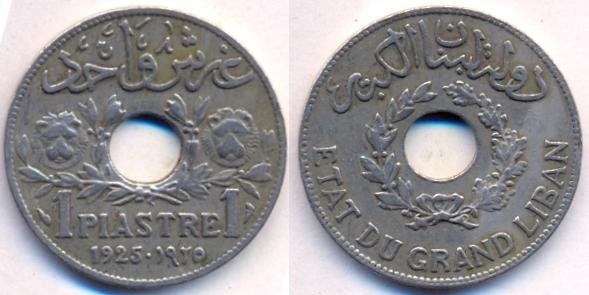 |
KM#3
1 piastre. Year:
1925.
Weight: 4.94g [5.00g].
Metal:
Copper-Nickel. Diameter:
24.00 mm with hole in center. Edge:
Plain.
Alignment: Coin.
Mint: Paris with
privy marks.
Obverse:
"One Piastre" in Arabic at top. Hole in center flanked by lion
heads with value "1 PIASTRE 1" and dates below. Paris privy mark on both sides.
Reverse:
"ETAT DU GRAND LIBAN" in French at bottom.
"دولة لبنان الكبير" in Arabic at top.
Wreath around the center hole.
Mintage:
1,500,000.
Minted Years:
1925, 1931, 1933 and 1936. |
|
 |
KM#5.1
5 piastres. Year:
1925.
Weight: 3.91g [4.00g].
Metal:
Aluminum-Bronze. Diameter:
23.00 mm. Edge:
Reeded.
Alignment: Coin.
Mint: Paris with
privy marks.
Obverse:
"5 Piastres" in Arabic at top. Traditional boat in center. "5 PIASTRES"
below the boat with Paris privy marks both on left side. Dates at bottom.
Reverse:
"ETAT DU GRAND LIBAN" in French at bottom.
"دولة لبنان الكبير" in Arabic at top.
Cedar Tree in
center.
Mintage:
1,500,000.
Minted Years:
One year type. |
|
 |
KM#5.2
5 piastres. Year:
1925.
Weight: 4.02g [4.00g].
Metal:
Aluminum-Bronze. Diameter:
23.00 mm. Edge:
Reeded.
Alignment: Coin.
Mint: Paris with
privy marks.
Obverse:
"5 Piastres" in Arabic at top. Traditional boat in center. "5
PIASTRES" below the boat with Paris privy mark on both sides. Dates at bottom.
Reverse:
"ETAT DU GRAND LIBAN" in French at bottom.
"دولة لبنان الكبير" in Arabic at top.
Cedar Tree in
center.
Mintage:
including above coin.
Minted Years:
1925, 1931, 1933, 1936 and 1940. |
|
|
|
|
1929 |
|
|
|
 |
KM#6
10 piastres. Year:
1929.
Weight: 1.96g [2.00g].
Metal: 0.680
silver. Diameter:
17.00 mm. Edge:
Reeded.
Alignment: Coin.
Mint:
N/A.
Obverse:
Cedar tree on rectangular box.
"الجمهورية
اللبنانية" written
in Arabic within rectangular box.
"REPUBLIQUE LIBANAISE" written in French below the rectangular box in
two lines. Date on both sides of the rectangular box.
Reverse:
"10 PIASTRES" written in Arabic at top and in English at bottom.
Crossed cornucopia in center.
Mintage:
880,000.
Minted Years:
One year type. |
|
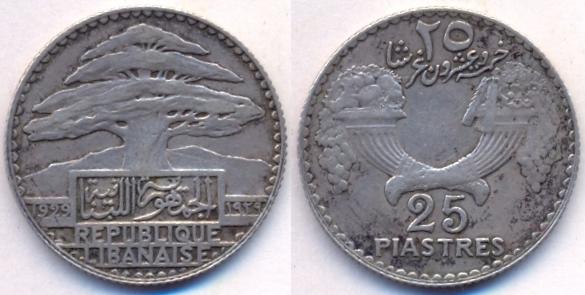 |
KM#7
25 piastres. Year:
1929.
Weight: 4.99g [5.00g].
Metal: 0.680
silver. Diameter:
24.00 mm. Edge:
Reeded.
Alignment: Coin.
Mint: N/A.
Obverse:
Cedar tree on rectangular box.
"الجمهورية
اللبنانية" written
in Arabic within rectangular box.
"REPUBLIQUE LIBANAISE" written in French below the rectangular box in
two lines. Date on both sides of the rectangular box.
Reverse:
"25 PIASTRES" written in Arabic at top and in English at bottom.
Crossed cornucopia in center.
Mintage:
200,000.
Minted Years:
1929, 1933 and 1936. |
|
 |
KM#8
50 piastres. Year:
1929.
Weight: 9.79g [10.00g].
Metal: 0.680
silver. Diameter:
27.00 mm. Edge:
Reeded.
Alignment: Coin.
Mint: N/A.
Obverse:
Cedar tree on rectangular box.
"الجمهورية
اللبنانية" written
in Arabic within rectangular box.
"REPUBLIQUE LIBANAISE" written in French below the rectangular box in
two lines. Date on both sides of the rectangular box.
Reverse:
"50 PIASTRES" written in Arabic at top and in English at bottom.
Crossed cornucopia in center.
Mintage:
500,000.
Minted Years:
1929, 1933 and 1936. |
|
|
|
|
1931 |
|
|
|
 |
KM#3
1 piastre. Year:
1931.
Weight: 4.89g [5.00g].
Metal:
Copper-Nickel. Diameter:
24.00 mm with hole in center. Edge:
Plain.
Alignment: Coin.
Mint: Paris with
privy marks.
Obverse:
"One Piastre" in Arabic at top. Hole in center flanked by lion
heads with value "1 PIASTRE 1" and dates below. Paris privy mark on both sides.
Reverse:
"ETAT DU GRAND LIBAN" in French at bottom.
"دولة لبنان الكبير" in Arabic at top.
Wreath around the center hole.
Mintage:
300,000.
Minted Years:
1925, 1931, 1933 and 1936. |
|
 |
KM#5.2
5 piastres. Year:
1931.
Weight: 3.65g [4.00g].
Metal:
Aluminum-Bronze. Diameter:
23.00 mm. Edge:
Reeded.
Alignment: Coin.
Mint: Paris with
privy marks.
Obverse:
"5 Piastres" in Arabic at top. Traditional boat in center. "5
PIASTRES" below the boat with Paris privy mark on both sides. Dates at bottom.
Reverse:
"ETAT DU GRAND LIBAN" in French at bottom.
"دولة لبنان الكبير" in Arabic at top.
Cedar Tree in
center.
Mintage:
400,000.
Minted Years:
1925, 1931, 1933, 1936 and 1940. |
|
|
|
|
1933 |
|
|
|
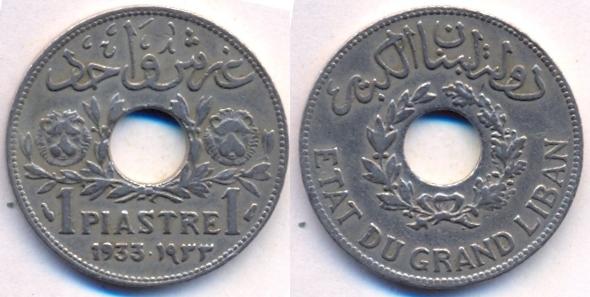 |
KM#3
1 piastre. Year:
1933.
Weight: 4.88g [5.00g].
Metal:
Copper-Nickel. Diameter:
24.00 mm with hole in center. Edge:
Plain.
Alignment: Coin.
Mint: Paris with
privy marks.
Obverse:
"One Piastre" in Arabic at top. Hole in center flanked by lion
heads with value "1 PIASTRE 1" and dates below. Paris privy mark on both sides.
Reverse:
"ETAT DU GRAND LIBAN" in French at bottom.
"دولة لبنان الكبير" in Arabic at top.
Wreath around the center hole.
Mintage:
500,000.
Minted Years:
1925, 1931, 1933 and 1936. |
|
 |
KM#5.2
5 piastres. Year:
1933.
Weight: 3.88g [4.00g].
Metal:
Aluminum-Bronze. Diameter:
23.00 mm. Edge:
Reeded.
Alignment: Coin.
Mint: Paris with
privy marks.
Obverse:
"5 Piastres" in Arabic at top. Traditional boat in center. "5
PIASTRES" below the boat with Paris privy mark on both sides. Dates at bottom.
Reverse:
"ETAT DU GRAND LIBAN" in French at bottom.
"دولة لبنان الكبير" in Arabic at top.
Cedar Tree in
center.
Mintage:
500,000.
Minted Years:
1925, 1931, 1933, 1936 and 1940. |
|
 |
KM#7
25 piastres. Year:
1933.
Weight: 4.96g [5.00g].
Metal: 0.680
silver. Diameter:
24.00 mm. Edge:
Reeded.
Alignment: Coin.
Mint: Paris with
privy marks.
Obverse: Cedar tree on rectangular box.
"الجمهورية
اللبنانية" written
in Arabic within rectangular box.
"REPUBLIQUE LIBANAISE" written in French below the rectangular box in
two lines. Date on both sides of the rectangular box.
Privy mark on both sides of
"REPUBLIQUE".
Reverse:
"25 PIASTRES" written in Arabic at top and in English at bottom.
Crossed cornucopia in center.
Mintage:
200,000.
Minted Years:
1929, 1933 and 1936. |
|
 |
KM#8
50 piastres. Year:
1933.
Weight: 9.92g [10.00g].
Metal: 0.680
silver. Diameter:
27.00 mm. Edge:
Reeded.
Alignment: Coin.
Mint: Paris with
privy marks.
Obverse: Cedar tree on rectangular box.
"الجمهورية
اللبنانية" written
in Arabic within rectangular box.
"REPUBLIQUE LIBANAISE" written in French below the rectangular box in
two lines. Date on both sides of the rectangular box.
Privy mark on both sides of
"REPUBLIQUE".
Reverse:
"50 PIASTRES" written in Arabic at top and in English at bottom.
Crossed cornucopia in center.
Mintage:
100,000.
Minted Years:
1929, 1933 and 1936. |
|
|
|
|
1934 |
|
|
|
 |
KM#9
½ piastre. Year:
1934.
Weight: 3.85g [4.00g].
Metal:
Copper-Nickel. Diameter:
21.00 mm. Edge:
Plain.
Alignment: Coin.
Mint: Paris with
privy marks.
Obverse:
"REPUBLIQUE LIBANAISE" at top.
Value "½ piastre" within sprigs in center.
Date at bottom.
Reverse:
Value in center within roped wreath flanked by oat sprigs above
date.
"الجمهورية اللبنانية" in Arabic at top. Date at bottom. Mintage:
200,000.
Minted Years:
1934 and 1936. |
|
|
|
|
1936 |
|
|
|
 |
KM#9
½ piastre. Year:
1936.
Weight: 4.15g [4.00g].
Metal:
Copper-Nickel. Diameter:
21.00 mm. Edge:
Plain.
Alignment: Coin.
Mint: Paris with
privy marks.
Obverse:
"REPUBLIQUE LIBANAISE" at top.
Value "½ piastre" within sprigs in center.
Date at bottom.
Reverse:
Value in center within roped wreath flanked by oat sprigs above
date.
"الجمهورية اللبنانية" in Arabic at top. Date at bottom. Mintage:
1,200,000.
Minted Years:
1934 and 1936. |
|
 |
KM#3
1 piastre. Year:
1936.
Weight: 4.94g [5.00g].
Metal:
Copper-Nickel. Diameter:
24.00 mm with hole in center. Edge:
Plain.
Alignment: Coin.
Mint: Paris with
privy marks.
Obverse:
"One Piastre" in Arabic at top. Hole in center flanked by lion
heads with value "1 PIASTRE 1" and dates below. Paris privy mark on both sides.
Reverse:
"ETAT DU GRAND LIBAN" in French at bottom.
"دولة لبنان الكبير" in Arabic at top.
Wreath around the center hole.
Mintage:
2,200,000.
Minted Years:
1925, 1931, 1933 and 1936. |
|
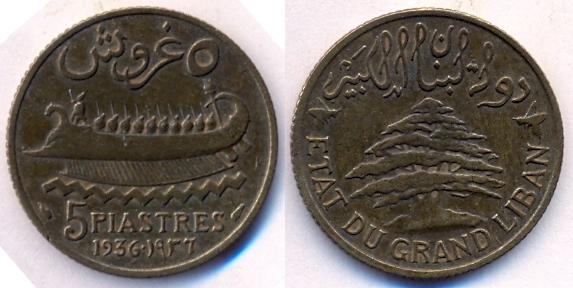 |
KM#5.2
5 piastres. Year:
1936.
Weight: 3.89g [4.00g].
Metal:
Aluminum-Bronze. Diameter:
23.00 mm. Edge:
Reeded.
Alignment: Coin.
Mint: Paris with
privy marks.
Obverse:
"5 Piastres" in Arabic at top. Traditional boat in center. "5
PIASTRES" below the boat with Paris privy mark on both sides. Dates at bottom.
Reverse:
"ETAT DU GRAND LIBAN" in French at bottom.
"دولة لبنان الكبير" in Arabic at top.
Cedar Tree in
center.
Mintage:
900,000.
Minted Years:
1925, 1931, 1933, 1936 and 1940. |
|
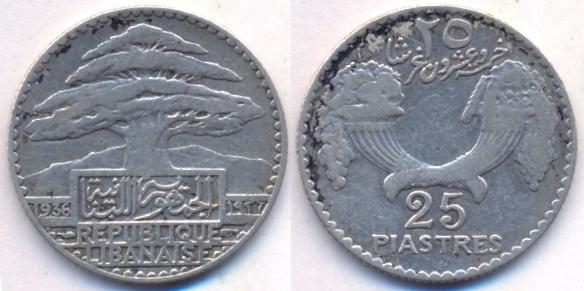 |
KM#7
25 piastres. Year:
1936.
Weight: 4.94g [5.00g].
Metal: 0.680
silver. Diameter:
24.00 mm. Edge:
Reeded.
Alignment: Coin.
Mint: Paris with
privy marks.
Obverse: Cedar tree on rectangular box.
"الجمهورية
اللبنانية" written
in Arabic within rectangular box.
"REPUBLIQUE LIBANAISE" written in French below the rectangular box in
two lines. Date on both sides of the rectangular box.
Privy mark on both sides of
"REPUBLIQUE".
Reverse:
"25 PIASTRES" written in Arabic at top and in English at bottom.
Crossed cornucopia in center.
Mintage:
400,000.
Minted Years:
1929, 1933 and 1936. |
|
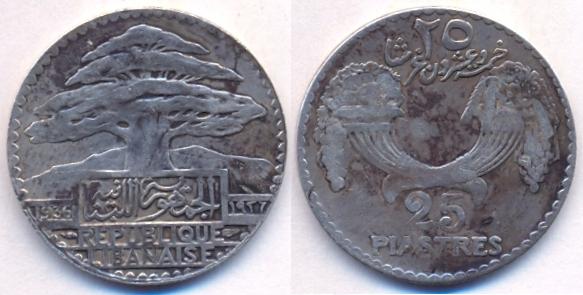 |
Same as above coin but "25 piastres" written
on obverse side is in thicker legend and the edge of the coin is
different. Probably a fake coin. |
|
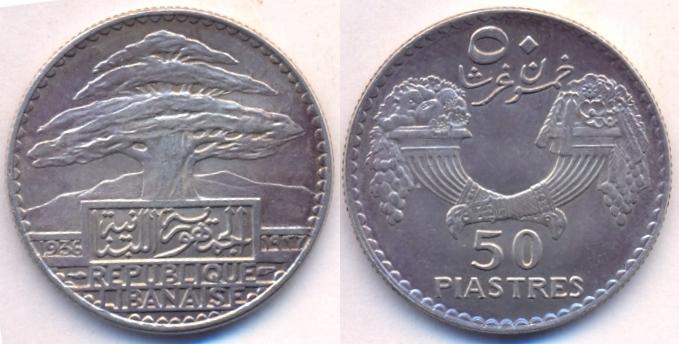 |
KM#8
50 piastres. Year:
1936.
Weight: 9.99g [10.00g].
Metal: 0.680
silver. Diameter:
27.00 mm. Edge:
Reeded.
Alignment: Coin.
Mint: Paris with
privy marks.
Obverse: Cedar tree on rectangular box.
"الجمهورية
اللبنانية" written
in Arabic within rectangular box.
"REPUBLIQUE LIBANAISE" written in French below the rectangular box in
two lines. Date on both sides of the rectangular box.
Privy mark on both sides of
"REPUBLIQUE".
Reverse:
"50 PIASTRES" written in Arabic at top and in English at bottom.
Crossed cornucopia in center.
Mintage:
100,000.
Minted Years:
1929, 1933 and 1936. |
|
|
|
|
1940 |
|
|
|
 |
KM#3a
1 piastre. Year:
1940.
Weight: 3.50g [3.50g].
Metal: Zinc.
Diameter:
24.25 mm with hole in center. Edge:
Plain.
Alignment: Coin.
Mint: Paris with
privy marks.
Obverse:
"One Piastre" in Arabic at top. Hole in center flanked by lion
heads with value "1 PIASTRE 1" and dates below. Privy marks
above lion heads.
Reverse:
"ETAT DU GRAND LIBAN" in French at bottom.
"دولة لبنان الكبير" in Arabic at top.
Wreath around the center hole.
Mintage:
2,000,000.
Minted Years:
One year type. |
|
 |
KM#10
2½ piastres. Year:
1940.
Weight: 3.06g [3.00g].
Metal:
Aluminum-Bronze. Diameter:
21.00 mm. Edge:
Plain.
Alignment: Coin.
Mint: Paris with
privy marks.
Obverse:
"½ piastres" in Arabic at top.
Hole in center flanked by lion heads with value "2 PIASTRES
½" and dates below.
Privy marks above lion heads.
Reverse:
Wreath around the center hole.
"الجمهورية
اللبنانية" written
in Arabic at top.
"REPUBLIQUE LIBANAISE" written in French at bottom.
Mintage:
1,000,000.
Minted Years:
One year type. |
|
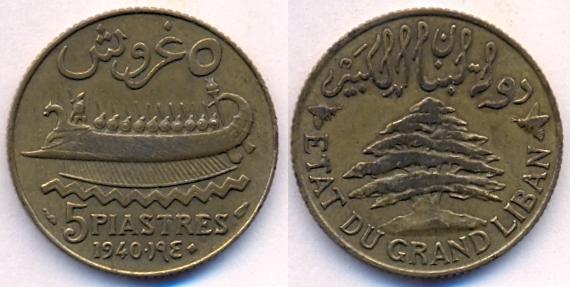 |
KM#5.2
5 piastres. Year:
1940.
Weight: 4.02g [4.00g].
Metal:
Aluminum-Bronze. Diameter:
23.00 mm. Edge:
Reeded.
Alignment: Coin.
Mint: Paris with
privy marks.
Obverse:
"5 Piastres" in Arabic at top. Traditional boat in center. "5
PIASTRES" below the boat with Paris privy mark on both sides. Dates at bottom.
Reverse:
"ETAT DU GRAND LIBAN" in French at bottom.
"دولة لبنان الكبير" in Arabic at top.
Cedar Tree in
center.
Mintage:
1,000,000.
Minted Years:
1925, 1931, 1933, 1936 and 1940. |
|
|
|
|
1941 |
|
|
|
 |
KM#9
½ piastre. Year:
1941.
Weight: 4.00g ? [4.00g ?].
Metal: Zinc.
Diameter:
21.00 mm. Edge:
Plain ?.
Alignment: Coin ?.
Mint: Paris with
privy marks.
Obverse:
"REPUBLIQUE LIBANAISE" at top.
Value "½ piastre" within sprigs in center.
Date at bottom.
Reverse:
Value in center within roped wreath flanked by oat sprigs above
date.
"الجمهورية اللبنانية" in Arabic at top. Date at bottom. Mintage:
1,000,000.
Minted Years:
One year type. |
|
|
|
|
ND (1941) - World War II Coinage |
|
|
|
.jpg) |
KM#11
½ piastre. Year:
ND (1941).
Weight: 2.15g [2.17g].
Metal: Brass.
Diameter:
17.25 mm; hole in center. Edge:
Plain.
Alignment: Medal.
Mint: N/A.
Obverse:
"LIBAN" at top.
Value "½" on both sides.
"PIASTRE" at the bottom.
Reverse:
"LUBNAN" in arabic at top.
Value "½" on both sides.
"PIASTRE" in Arabic at the bottom. Mintage:
N/A.
Minted Years:
One year type. |
|
Note: Three varieties are known.
Usually crudely struck, off-center, etc. Perfectly struck, centered
uncirculated specimens command a considerable premium. Finely struck
coins appear with medal rotation while crude examples have coin
rotation. Size of letters also vary. |
|
_Rotated.jpg) |
Probably another variety. Same as
above coin but with thick legends and rotated as shown.
Weight: 2.15g. |
|
.jpg) |
KM#12
1 piastre. Year:
ND (1941).
Weight: 2.56g.
Metal: Brass.
Diameter:
17.25 mm. Edge:
Plain.
Alignment: Medal.
Mint: N/A.
Obverse:
"LIBAN" at top.
Value "1" in center and "PIASTRE" at the
bottom.
Reverse:
"LUBNAN" in arabic at top.
Value "1" in center. "PIASTRE" in Arabic
at the bottom. Mintage:
N/A.
Minted Years:
One year type. |
|
Note: Two varieties are known.
Usually crudely struck, off-center, etc. Perfectly struck, centered unc.
specimens command a considerable premium. KM#12a/Lecompte-47 exits in
Aluminum is extremely rare (estimated value: $3000). One of such
Aluminum piece brought €3,700 in iNumis Mail Bid Sale 29, Lot 1034. |
|
_Rotated.jpg) |
Probably another variety. Same as
above coin but with thin legends on obverse side and rotated as shown.
Weight: 2.40g. |
|
.jpg) |
KM#13
2½ piastres. Year:
ND (1941).
Weight: 1.21g.
Metal: Aluminum.
Diameter:
17.25 mm. Edge:
Plain.
Alignment: Medal.
Mint: N/A.
Obverse:
"LIBAN" at top.
Value "2½" in center and "PIASTRES" at
the bottom.
Reverse:
"LUBNAN" in arabic at top.
Value "2½" in center. "PIASTRE" in Arabic
at the bottom. Mintage:
N/A.
Minted Years:
One year type. |
|
Note: Seven varieties are known.
Usually crudely struck, off-center, etc. Perfectly struck, centered unc.
specimens command a considerable premium. |
|
_Rotated.jpg) |
Probably another variety. Same as
above coin but with thick legends, off-center from reverse side and
rotated as shown. Weight:
1.27g. |
|
Another coins also exists in this series:
-
KM#13a
2½ piastres. Year:
ND (1941).
Weight: N/A.
Metal:
Aluminum-Bronze. Diameter:
17.25 mm. Edge:
Plain.
Alignment: Medal.
Mint: N/A.
Obverse:
"LIBAN" at top.
Value "2½" in center and "PIASTRES" at
the bottom.
Reverse:
"LUBNAN" in arabic at top.
Value "2½" in center. "PIASTRE" in Arabic
at the bottom. Mintage:
N/A.
Minted Years:
One year type. Note: Scarce
coin.
-
KM#A14
5 piastres.
Year: ND (1941).
Weight: N/A.
Metal: Aluminum.
Diameter:
probably 21.00 mm. Edge:
Plain. Alignment:
Medal. Mint:
N/A.
Obverse: "LIBAN" at top.
Value "5" in center and "PIASTRES"
at the bottom. Reverse:
"LUBNAN" in
arabic at top. Value "5" in
center. "PIASTRE" in Arabic at the bottom. Mintage:
N/A. Minted Years:
One year type.
Note: 5 piastres did not enter
circulation in significant numbers, therefore are expense and
considered rare.
|
|
|
|
|
|
- Independent Presidents - Lebanese
Republic
- Béchara
Khalil
El-Khoury (2nd
time)..............22
Nov 1943 - 18 Sep 1952
- On 22 Nov 1943, France
recognized the independence.
- Fouad
Abdallah
Chehab (1st
time - acting)........18
Sep 1952 - 22 Sep 1952
- Camille
Nimer
Chamoun............................23
Sep 1952 - 22 Sep 1958
- Fouad
Abdallah
Chehab (2nd
time).................23
Sep 1958 - 22 Sep 1964
- Charles
Alexandre
Hélou..........................23
Sep 1964 - 22 Sep 1970
- Suleiman
Kabalan
Franjieh........................23
Sep 1970 - 22 Sep 1976
- Although the Government of Lebanon retains
international recognition as a sovereign entity, it needs to be noted that
since 1975, the country has been occupied by a large number of foreign
military organizations (notably the Israeli Army in the south until 2000,
the Syrian Army in the east, and many different terrorist and/or nationalist
groups in the center and the south since 2000). The Lebanese Civil War
was a multifaceted civil war in Lebanon. The war lasted from 13 April 1975
to 13 October 1990 and resulted in an estimated 150,000 to 230,000 civilian
fatalities. Another one million people (a quarter of the population) were
wounded, and today approximately 350,000 people remain displaced. There was
also a mass exodus of almost one million people from Lebanon. Taif Agreement
(Christian 6:5 ascendancy replaced by 1:1 representation Muslim
prime-ministerial powers strengthened), PLO expulsion from Lebanon, Syrian
de facto occupation almost all Lebanon (1976–2005) with 30,000 soldiers and
Israeli occupation of South Lebanon were the aftermath of this war.
- In 1976, as a result of the ongoing civil war, the
Lebanese army began to break up. Major Saad Haddad, commanding an army
battalion in the south that had been part of the Army of Free Lebanon, broke
away and founded a group known as the Free Lebanon Army (FLA). The FLA was
initially based in the towns of Marjayoun and Qlayaa in southern Lebanon,
later known as SLA. South Lebanon Army (SLA) was supported by Israel during
the 1982–2000 South Lebanon conflict to fight against various groups
including the Amal Movement, Palestine Liberation Organisation (PLO) and
Hezbollah. SLA was no longer under the direct control of the Lebanese army,
but from 1976-1979 its members were still paid as Lebanese soldiers by the
government.
- Elias Sarkis.....................................23
Sep 1976 - 22 Sep 1982
-
The Israeli-Lebanese conflict started on
06 June 1982, Israeli forces under direction of Defence Minister
Ariel Sharon invaded southern Lebanon in "Operation Peace for
Galilee" started the Lebanese civil war. On 14 September 1982,
Bachir Gemayel, the newly elected President of Lebanon, was
assassinated by Habib Shartouni of the Syrian Social Nationalist
Party. Israeli forces occupied West Beirut the next day. At that
time, the Lebanese Christian Militia, also known as the
Phalangists, were allied with Israel. The Israeli command
authorized the entrance of a force of approximately 150
Phalangist fighters' into the Sabra and Shatila refugee camps,
claiming there was a remaining force of approximately "2000 PLO
terrorists" in the camps. The result was the Sabra and Shatila
massacre in which at least 800 civilians were killed by the
Phalangists between September 16 and September 18, 1982. Various
forces (Israeli, Phalangist and possibly SLA) were in the
vicinity. The actual killers were "the Young Men", a gang (Kataeb
Party militia) recruited by Elie Hobeika, the Lebanese Forces
intelligence chief, from men who had been expelled from the
Lebanese Forces for insubordination or criminal activities. The
massacre took place under Hobeika's direct orders. Hobeika's
family and fiancée had been murdered by Palestinian militiamen
at the Damour massacre of 1976. Hobeika later became a
long-serving Member of the Parliament of Lebanon and served in
several ministerial roles. On 17 May 1983, Lebanon's Amine
Gemayel, Israel, and the United States signed an agreement text
on Israeli withdrawal that was conditioned on the departure of
Syrian troops; reportedly after the US and Israel exerted severe
pressure on Gemayel. The agreement stated that "the state of war
between Israel and Lebanon has been terminated and no longer
exists." Thus, the agreement in effect amounted to a peace
agreement with Israel, and was additionally seen by many
Lebanese Muslims as an attempt for Israel to gain a permanent
hold on the Lebanese South.
- Some parts Occupied by the PLO...................06
Jun 1982 - 17 May 1983
- After Palestine Liberation
Organization founding in 1964 and the radicalization among Palestinians,
which followed the Six Day War, the PLO became a powerful force, then
centered in Jordan. The large influx of Palestinians from Jordan after
“Black September” caused an additional demographic imbalance within Lebanese
society and its democratic institutions established earlier by the National
Pact. By 1975, the refugees numbered more than 300,000 and the PLO in effect
created an unofficial state-within-a-state, particularly in Southern
Lebanon, which then played an important role in the Lebanese Civil War. The
PLO had around 15,000 – 18,000 fighters (of whom about 5,000–6,000 were
alleged to be foreign mercenaries (or volunteers) from such countries as
Libya, Iraq, India, Sri Lanka, Chad and Mozambique) and they were disposed
as follows: 6,000 in the Beirut, Ba'abda and Damour area, 1,500 in Sidon,
1,000 between Sidon and Tyre, 1,500 in Tyre, 1,000 deployed from Nabatiyeh
to Beaufort Castle, 2,000 in Fatahland, and around 1,000 in the UNIFIL Zone.
PLO were were expulsed on 17 May 1983 from
Lebanon.
- Amin
Pierre
Gemayel..............................23 Sep 1982 - 22 Sep 1988
- On 16 February 1985, Shia
Sheik Ibrahim al-Amin declared a manifesto in Lebanon, announcing a
resistance movement called Hezbollah, whose goals included combating the
Israeli occupation. During the 1982-2000 South Lebanon conflict the
Hezbollah militia waged a guerrilla campaign against Israeli forces
occupying Southern Lebanon and their South Lebanon Army proxies. Throughout
the period of 1985-1992, there were very few limited exchanges between
Israeli and Hezbollah or Amal forces in southern Lebanon.
|
|
|
|
Currency: Livre (Pound) = 100 piastres. |
|
After the war, the Arabic spelling was changed from girsh
(غرش) to qirsh (قرش). Coins were issued in the period 1952 to 1986 in
denominations of 1, 2½, 5, 10, 25 and 50 qirsh and 1 lira. No coins were issued
between 1986 and 1995. |
|
|
|
1952 |
|
|
|
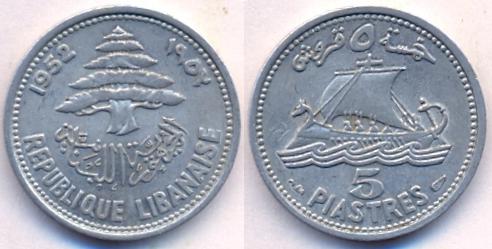 |
KM#14 5 piastres. Year:
1952.
Weight: 0.95g [1.00g].
Metal: Aluminum.
Diameter:
20.00 mm. Edge:
Plain.
Alignment: Coin.
Mint: Paris with
privy marks.
Obverse:
Dates on top at left and right. Cedar tree in center.
"الجمهورية اللبنانية"
in Arabic below the Cedar tree.
"REPUBLIQUE LIBANAISE" at bottom.
Reverse:
Traditional boat in center. "خمسة 5 قروش" in Arabic at top. "5
PIASTRES"
in English with Paris privy marks on both sides
at bottom. Mintage:
3,600,000.
Minted Years:
One year type. |
|
 |
KM#15 10 piastres. Year:
1952.
Weight: 1.29g [1.30g].
Metal: Aluminum.
Diameter:
21.80 mm. Edge:
Plain.
Alignment: Coin.
Mint: Paris with
privy marks.
Obverse:
Dates below the Cedar tree in center.
"الجمهورية اللبنانية"
in Arabic at the top.
"REPUBLIQUE LIBANAISE" at bottom.
Reverse:
Lion head in center with numeral 10 on both sides.
"قروش" in Arabic at top. "PIASTRES"
in English with Paris privy marks on both sides
at bottom. Mintage:
3,600,000.
Minted Years:
One year type. |
|
 |
KM#16.1
25 piastres. Year:
1952.
Weight: 3.94g [4.00g].
Metal:
Aluminum-Bronze. Diameter:
23.25 mm. Edge:
Reeded.
Alignment: Medal.
Mint: Utrecht,
Netherlands.
Obverse:
Value within rectangular box divides
wreath and dates.
Reverse:
Cedar tree. "الجمهورية اللبنانية"
[al-Jumhuriya(t)
al-Lubnaniya(t)] in Arabic and "REPUBLIQUE LIBANAISE" in French below
the tree. Mintage:
7,200,000.
Minted Years:
One year type. |
|
 |
KM#17
50 piastres. Year:
1952.
Weight: 3.95g [4.9710g].
Metal: 0.600
silver. Diameter:
24.00 mm. Edge:
Reeded.
Alignment: Medal.
Mint: Utrecht,
Netherlands.
Obverse:
Dates below
Cedar tree. "الجمهورية اللبنانية"
[al-Jumhuriya(t)
al-Lubnaniya(t)] in Arabic on top and "REPUBLIQUE
LIBANAISE" in French below the tree.
Reverse:
Value within wreath. Mintage:
7,200,000.
Minted Years:
One year type. |
|
|
|
|
1954 |
|
|
|
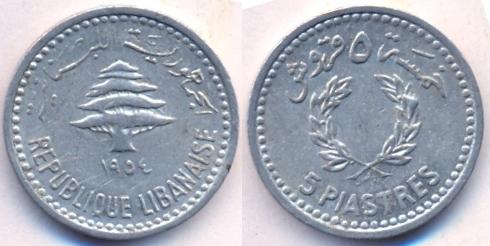 |
KM#18 5 piastres. Year:
1954.
Weight: 1.00g [1.00g].
Metal: Aluminum.
Diameter:
20.00 mm. Edge:
Plain.
Alignment: Medal.
Mint: N/A.
Obverse:
Date below Cedar tree in center.
"الجمهورية اللبنانية"
in Arabic at top.
"REPUBLIQUE LIBANAISE" at bottom.
Reverse:
Wreath in center with
value "خمسة 5 قروش" in Arabic at top and "5 PIASTRES" in English at
bottom. Mintage:
4,400,000.
Minted Years:
One year type. |
|
|
|
|
1955 |
|
|
|
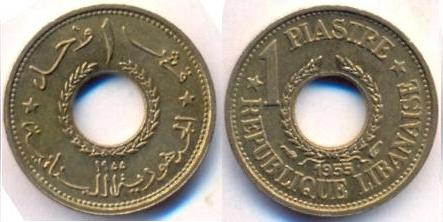 |
KM#19 1 piastre. Year:
1955.
Weight: 2.01g [2.00g].
Metal:
Aluminum-Bronze. Diameter:
18.00 mm. Edge:
Plain.
Alignment: Coin.
Mint: Paris with
privy marks.
Obverse:
Hole in center surrounded by wreath and Date below it. "قرشا 1 واحد"
at the top.
"الجمهورية اللبنانية"
in Arabic at bottom.
Reverse:
Hole in center
surrounded by wreath with Date below it.
Paris privy marks on both
sides of the date. "1 PIASTRE" at the top.
"REPUBLIQUE LIBANAISE" at bottom. Mintage:
4,000,000.
Minted Years:
One year type. |
|
 |
KM#20 2½ piastres. Year:
1955.
Weight: 2.75g [2.75g].
Metal:
Aluminum-Bronze. Diameter:
20.00 mm. Edge:
Plain.
Alignment: Coin.
Mint: Paris with
privy marks.
Obverse:
Hole in center surrounded by wreath and Date below it. Value in
Arabic at the top.
"الجمهورية اللبنانية"
in Arabic at bottom.
Reverse:
Hole in center
surrounded by wreath with Date below it. Paris privy marks on both sides
of the date. "2½
PIASTRE 2½"
at the top.
"REPUBLIQUE LIBANAISE" at bottom. Mintage:
5,000,000.
Minted Years:
One year type. |
|
 |
KM#21 5 piastres. Year:
1955.
Weight: 2.79g [2.85g].
Metal:
Aluminum-Bronze. Diameter:
19.50 mm. Edge:
Plain.
Alignment: Coin.
Mint: Paris with
privy marks.
Obverse:
Cedar tree in center with
and Date below it.
"الجمهورية اللبنانية"
in Arabic at bottom.
"5 قروش" at the top.
Reverse:
Lion head in center. "5 PIASTRES" at top. Paris privy marks on both
sides of the date below lion head.
"REPUBLIQUE LIBANAISE" at bottom. Mintage:
3,000,000.
Minted Years:
1955 and 1961. |
|
 |
KM#22 10 piastres. Year:
1955.
Weight: 3.57g [3.60g].
Metal:
Aluminum-Bronze. Diameter:
21.50 mm. Edge:
Reeded.
Alignment: Medal.
Mint:
N/A.
Obverse:
Traditional boat at the top,
"الجمهورية اللبنانية"
in Arabic below the boat with date between them.
"REPUBLIQUE LIBANAISE" at bottom.
Reverse:
Cedar Tree on the right side with value in Arabic "10 قروش" at the
left side. "10 PIASTRES" at the bottom.
Mintage:
2,175,000.
Minted Years:
One year type. |
|
 |
It has the same weight of 3.57g with slightly
more thicker edge and probably slightly different reeding. |
|
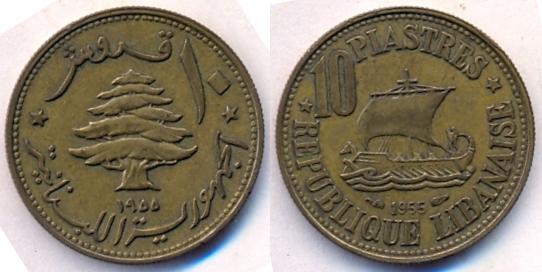 |
KM#23 10 piastres. Year:
1955.
Weight: 3.42g [3.45g].
Metal:
Aluminum-Bronze. Diameter:
21.50 mm. Edge:
Reeded.
Alignment: Coin.
Mint: Paris with
privy marks.
Obverse:
Cedar tree in center with
and Date below it.
"الجمهورية اللبنانية"
in Arabic at bottom.
"10 قروش" at the top.
Reverse:
Traditional boat in
center. "10 PIASTRES" at top. Paris privy marks on both sides of the
date below the boat.
"REPUBLIQUE LIBANAISE" at bottom. Mintage:
6,000,000.
Minted Years:
One year type. |
|
|
|
|
1961 |
|
|
|
 |
KM#21 5 piastres. Year:
1961.
Weight: 2.89g [2.85g].
Metal:
Aluminum-Bronze. Diameter:
19.50 mm. Edge:
Plain.
Alignment: Coin.
Mint: Paris with
privy marks.
Obverse:
Cedar tree in center with
and Date below it.
"الجمهورية اللبنانية"
in Arabic at bottom.
"5 قروش" at the top.
Reverse:
Lion head in center. "5 PIASTRES" at top. Paris privy marks on both
sides of the date below lion head.
"REPUBLIQUE LIBANAISE" at bottom. Mintage:
N/A.
Minted Years:
1955 and 1961. |
|
 |
KM#24 10 piastres. Year:
1961.
Weight: 3.45g [3.45g].
Metal:
Copper-Nickel. Diameter:
21.50 mm. Edge:
Reeded.
Alignment: Coin.
Mint: N/A.
Obverse:
Cedar tree in center with
and Date below it.
"الجمهورية اللبنانية"
in Arabic at bottom.
"10 قروش" at the top.
Reverse:
Traditional boat in
center. "10 PIASTRES" at top. Date below the boat.
"REPUBLIQUE LIBANAISE" at bottom. Mintage:
7,000,000.
Minted Years:
One year type.
Note:
This coin also exists in Proof. |
|
 |
KM#16.2
25 piastres. Year:
1961.
Weight: 3.99g [4.00g].
Metal:
Aluminum-Bronze. Diameter:
23.25 mm. Edge:
Reeded.
Alignment: Medal.
Mint: Utrecht,
Netherlands.
Obverse:
Value within rectangular box divides
wreath and dates.
Reverse:
Cedar tree. "al-Jumhuriya(t)
al-Lubnaniya(t)" in Arabic and "REPUBLIQUE LIBANAISE" in French below
the tree. Mintage:
5,000,000.
Minted Years:
One year type.
Note:
Larger date than the 1952 coin. |
|
|
|
|
1968 |
|
|
|
 |
KM#25.1
5 piastres. Year:
1968.
Weight: 2.17g [2.20g].
Metal:
Nickel-Brass. Diameter:
18.00 mm. Edge:
Reeded.
Alignment:
Coin.
Mint: N/A.
Obverse:
"مصرف
لبنان" [Masraf Lubnan] in Arabic and "BANQUE DU LIBAN" in French below the
Cedar tree.
Dates between both languages.
Reverse:
Value within wreath. Mintage:
2,000,000.
Minted Years:
1968-1970. |
|
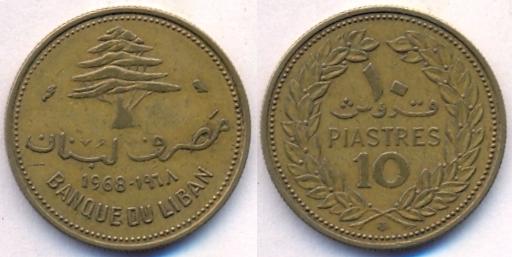 |
KM#26
10 piastres. Year:
1968.
Weight: 3.13g [3.20g].
Metal:
Nickel-Brass. Diameter:
20.25 mm. Edge:
Reeded.
Alignment:
Coin.
Mint: Paris with
privy marks.
Obverse:
"مصرف
لبنان" [Masraf Lubnan] in Arabic and "BANQUE DU LIBAN" in French below the
Cedar tree.
Dates between both languages.
Paris privy mark on both sides of Cedar Tree.
Reverse:
Value within wreath. Mintage:
2,000,000.
Minted Years:
1968-1970, 1972 and 1975. |
|
 |
KM#27.1
25 piastres. Year:
1968.
Weight: 3.96g [4.00g].
Metal:
Aluminum-Bronze. Diameter:
23.30 mm. Edge:
Reeded.
Alignment:
Coin.
Mint: N/A.
Obverse:
Cedar tree. "مصرف
لبنان" [Masraf Lubnan] in Arabic and "BANQUE DU LIBAN" in French below the tree.
Dates between both languages.
Reverse:
Value within wreath. Mintage:
1,500,000.
Minted Years:
1968-1970, 1972 and 1975. |
|
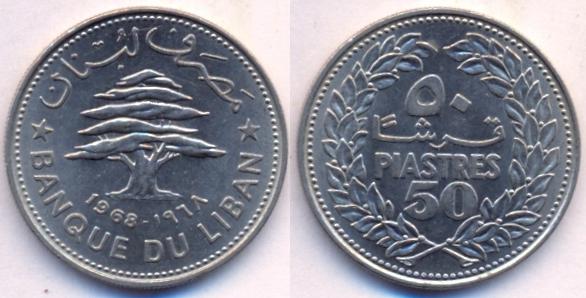 |
KM#28.1
50 piastres. Year:
1968.
Weight: 5.90g [6.00g].
Metal: Nickel.
Diameter:
24.00 mm. Edge:
Reeded.
Alignment: Coin.
Mint: N/A.
Obverse:
Dates below
Cedar tree. "مصرف لبنان" [Masraf Lubnan] in Arabic on top and "BANQUE DU LIBAN" in French below the tree.
Reverse:
Value within wreath. Mintage:
2,000,000.
Minted Years:
1968-1971, 1975 and 1978. |
|
 |
KM#29
1 Livre. Year:
1968.
Weight: 10.00g [10.00g].
Metal: Nickel.
Diameter:
27.00 mm. Edge:
Reeded.
Alignment: Medal.
Mint: N/A.
Obverse:
Dates below
Cedar tree. "مصرف لبنان" [Masraf Lubnan] in Arabic on top and "BANQUE DU LIBAN" in French below the tree.
Reverse:
Cluster of fruits in center. Value
in Arabic on top right and in English below the fruits. Mintage:
300,000.
Minted Years:
One year type. |
|
|
|
|
1969 |
|
|
|
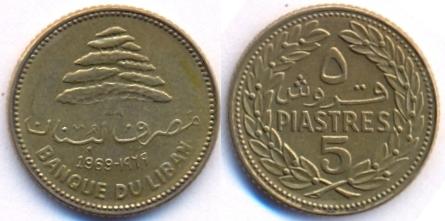 |
KM#25.1
5 piastres. Year:
1969.
Weight: 2.18g [2.20g].
Metal:
Nickel-Brass. Diameter:
18.00 mm. Edge:
Reeded.
Alignment:
Coin.
Mint: N/A.
Obverse:
"مصرف
لبنان" [Masraf Lubnan] in Arabic and "BANQUE DU LIBAN" in French below the
Cedar tree.
Dates between both languages.
Reverse:
Value within wreath. Mintage:
4,000,000.
Minted Years:
1968-1970. |
|
 |
KM#26
10 piastres. Year:
1969.
Weight: 3.13g [3.20g].
Metal:
Nickel-Brass. Diameter:
20.25 mm. Edge:
Reeded.
Alignment:
Coin.
Mint: Paris with
privy marks.
Obverse:
"مصرف
لبنان" [Masraf Lubnan] in Arabic and "BANQUE DU LIBAN" in French below the
Cedar tree.
Dates between both languages.
Paris privy mark on both sides of Cedar Tree.
Reverse:
Value within wreath. Mintage:
5,000,000.
Minted Years:
1968-1970, 1972 and 1975. |
|
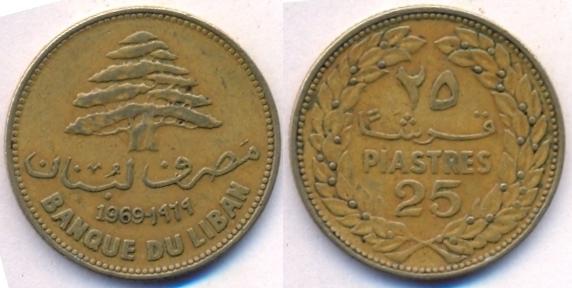 |
KM#27.1
25 piastres. Year:
1969.
Weight: 3.86g [4.00g].
Metal:
Aluminum-Bronze. Diameter:
23.30 mm. Edge:
Reeded.
Alignment:
Coin.
Mint: N/A.
Obverse:
Cedar tree. "مصرف
لبنان" [Masraf Lubnan] in Arabic and "BANQUE DU LIBAN" in French below the tree.
Dates between both languages.
Reverse:
Value within wreath. Mintage:
2,500,000.
Minted Years:
1968-1970, 1972 and 1975. |
|
 |
KM#28.1
50 piastres. Year:
1969.
Weight: 5.97g [6.00g].
Metal: Nickel.
Diameter:
24.00 mm. Edge:
Reeded.
Alignment: Coin.
Mint: N/A.
Obverse:
Dates below
Cedar tree. "مصرف لبنان" [Masraf Lubnan] in Arabic on top and "BANQUE DU LIBAN" in French below the tree.
Reverse:
Value within wreath. Mintage:
3,488,000.
Minted Years:
1968-1971, 1975 and 1978. |
|
|
|
|
1970 |
|
|
|
 |
KM#25.1
5 piastres. Year:
1970.
Weight: 2.18g [2.20g].
Metal:
Nickel-Brass. Diameter:
18.00 mm. Edge:
Reeded.
Alignment:
Coin.
Mint: N/A.
Obverse:
"مصرف
لبنان" [Masraf Lubnan] in Arabic and "BANQUE DU LIBAN" in French below the
Cedar tree.
Dates between both languages.
Reverse:
Value within wreath. Mintage:
N/A.
Minted Years:
1968-1970. |
|
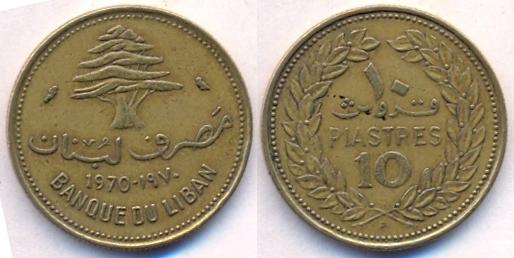 |
KM#26
10 piastres. Year:
1970.
Weight: 3.20g [3.20g].
Metal:
Nickel-Brass. Diameter:
20.25 mm. Edge:
Reeded.
Alignment:
Coin.
Mint: Paris with
privy marks.
Obverse:
"مصرف
لبنان" [Masraf Lubnan] in Arabic and "BANQUE DU LIBAN" in French below the
Cedar tree.
Dates between both languages.
Paris privy mark on both sides of Cedar Tree.
Reverse:
Value within wreath. Mintage:
8,000,000.
Minted Years:
1968-1970, 1972 and 1975. |
|
 |
KM#27.1
25 piastres. Year:
1970.
Weight: 3.93g [4.00g].
Metal:
Aluminum-Bronze. Diameter:
23.30 mm. Edge:
Reeded.
Alignment:
Coin.
Mint: N/A.
Obverse:
Cedar tree.
"مصرف لبنان" [Masraf Lubnan] in Arabic and "BANQUE DU LIBAN" in French below the tree.
Dates between both languages.
Reverse:
Value within wreath. Mintage:
N/A.
Minted Years:
1968-1970, 1972 and 1975. |
|
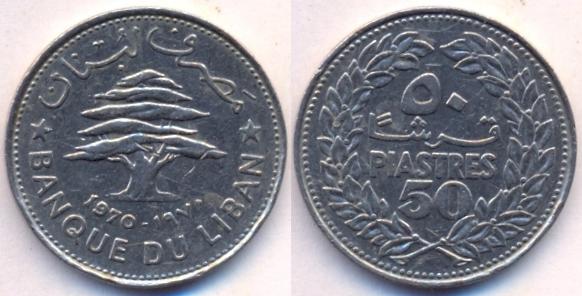 |
KM#28.1
50 piastres. Year:
1970.
Weight: 5.81g [6.00g].
Metal: Nickel.
Diameter:
24.00 mm. Edge:
Reeded.
Alignment: Coin.
Mint: N/A.
Obverse:
Dates below
Cedar tree. "مصرف لبنان" [Masraf Lubnan] in Arabic on top and "BANQUE DU LIBAN" in French below the tree.
Reverse:
Value within wreath. Mintage:
2,000,000.
Minted Years:
1968-1971, 1975 and 1978. |
|
|
|
|
1971 |
|
|
|
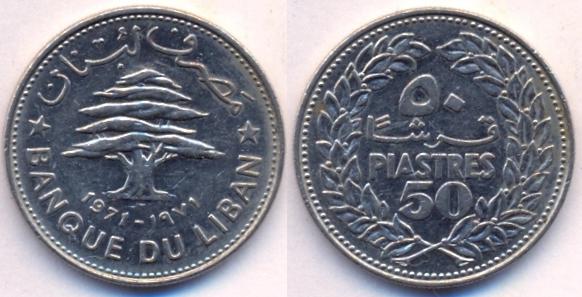 |
KM#28.1
50 piastres. Year:
1971.
Weight: 5.92g [6.00g].
Metal: Nickel.
Diameter:
24.00 mm. Edge:
Reeded.
Alignment: Coin.
Mint: N/A.
Obverse:
Dates below
Cedar tree. "مصرف لبنان" [Masraf Lubnan] in Arabic on top and "BANQUE DU LIBAN" in French below the tree.
Reverse:
Value within wreath. Mintage:
2,000,000.
Minted Years:
1968-1971, 1975 and 1978. |
|
|
|
|
1972 |
|
|
|
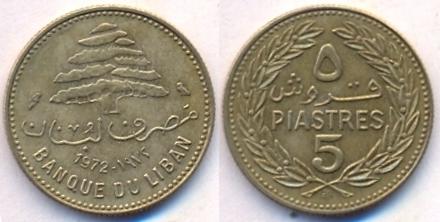 |
KM#25.2
5 piastres. Year:
1972.
Weight: 2.18g [2.20g].
Metal:
Nickel-Brass. Diameter:
18.00 mm. Edge:
Reeded.
Alignment:
Coin.
Mint: Paris with
privy marks.
Obverse:
"مصرف
لبنان" [Masraf Lubnan] in Arabic and "BANQUE DU LIBAN" in French below the
Cedar tree.
Dates between both languages.
Paris privy mark on both sides of Cedar Tree.
Reverse:
Value within wreath.
Mintage:
12,000,000.
Minted Years:
1972, 1975 and 1980.
Note:
Edge reeding differs from 1968-1970 issue. |
|
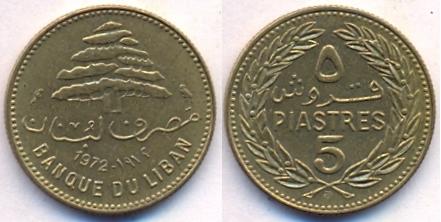 |
Same as above coin but probably having less
Nickel contents. |
|
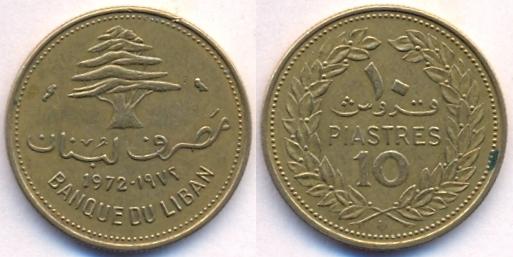 |
KM#26
10 piastres. Year:
1972.
Weight: 3.27g [3.20g].
Metal:
Nickel-Brass. Diameter:
20.25 mm. Edge:
Reeded.
Alignment:
Coin.
Mint: Paris with
privy marks.
Obverse:
"مصرف
لبنان" [Masraf Lubnan] in Arabic and "BANQUE DU LIBAN" in French below the
Cedar tree.
Dates between both languages.
Paris privy mark on both sides of Cedar Tree.
Reverse:
Value within wreath. Mintage:
12,000,000.
Minted Years:
1968-1970, 1972 and 1975. |
|
 |
KM#27.1
25 piastres. Year:
1972.
Weight: 3.93g [4.00g].
Metal:
Aluminum-Bronze. Diameter:
23.30 mm. Edge:
Reeded.
Alignment:
Coin.
Mint: N/A.
Obverse:
Cedar tree.
"مصرف لبنان" [Masraf Lubnan] in Arabic and "BANQUE DU LIBAN" in French below the tree.
Dates between both languages.
Reverse:
Value within wreath. Mintage:
8,000,000.
Minted Years:
1968-1970, 1972 and 1975. |
|
|
|
|
1975 |
|
|
|
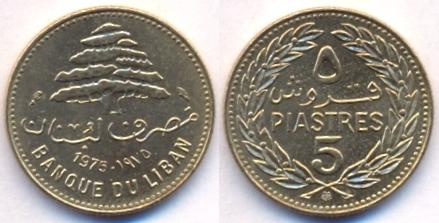 |
KM#25.2
5 piastres. Year:
1975.
Weight: 2.22g [2.20g].
Metal:
Nickel-Brass. Diameter:
18.00 mm. Edge:
Reeded.
Alignment:
Coin.
Mint: Paris with
privy marks.
Obverse:
"مصرف
لبنان" [Masraf Lubnan] in Arabic and "BANQUE DU LIBAN" in French below the
Cedar tree.
Dates between both languages.
Paris privy mark on both sides of Cedar Tree.
Reverse:
Value within wreath. Mintage:
N/A.
Minted Years:
1972, 1975 and 1980.
Note:
Edge reeding differs from 1968-1970 issue. |
|
 |
KM#26
10 piastres. Year:
1975.
Weight: 3.22g [3.20g].
Metal:
Nickel-Brass. Diameter:
20.25 mm. Edge:
Reeded.
Alignment:
Coin.
Mint: Paris with
privy marks.
Obverse:
"مصرف
لبنان" [Masraf Lubnan] in Arabic and "BANQUE DU LIBAN" in French below the
Cedar tree.
Dates between both languages.
Paris privy mark on both sides of Cedar Tree.
Reverse:
Value within wreath. Mintage:
N/A.
Minted Years:
1968-1970, 1972 and 1975. |
|
 |
KM#27.1
25 piastres. Year:
1975.
Weight: 3.96g [4.00g].
Metal:
Aluminum-Bronze. Diameter:
23.30 mm. Edge:
Reeded.
Alignment:
Coin.
Mint: N/A.
Obverse:
Cedar tree. "مصرف
لبنان" [Masraf Lubnan] in Arabic and "BANQUE DU LIBAN" in French below the tree.
Dates between both languages.
Reverse:
Value within wreath. Mintage:
N/A.
Minted Years:
1968-1970, 1972 and 1975. |
|
 |
KM#28.1
50 piastres. Year:
1975.
Weight: 5.92g [6.00g].
Metal: Nickel.
Diameter:
24.00 mm. Edge:
Reeded.
Alignment: Coin.
Mint: N/A.
Obverse:
Dates below
Cedar tree. "مصرف لبنان" [Masraf Lubnan] in Arabic on top and "BANQUE DU LIBAN" in French below the tree.
Reverse:
Value within wreath. Mintage:
N/A.
Minted Years:
1968-1971, 1975 and 1978. |
|
 |
KM#30
1 Livre. Year:
1975.
Weight: 7.86g [8.00g].
Metal: Nickel.
Diameter:
27.00 mm. Edge:
Reeded.
Alignment:
Coin.
Mint: N/A.
Obverse:
Dates below
Cedar tree. "مصرف لبنان" [Masraf Lubnan] in Arabic on top and "BANQUE DU LIBAN" in French below the tree.
Reverse:
Value within wreath. Mintage:
N/A.
Minted Years:
1975, 1977, 1980 and 1981. Note:
Proof coin also exists. |
|
|
|
|
1977 |
|
|
|
 |
KM#30
1 Livre. Year:
1977.
Weight: 7.95g [8.00g].
Metal: Nickel.
Diameter:
27.00 mm. Edge:
Reeded.
Alignment:
Coin.
Mint: N/A.
Obverse:
Dates below
Cedar tree. "مصرف لبنان" [Masraf Lubnan] in Arabic on top and "BANQUE DU LIBAN" in French below the tree.
Reverse:
Value within wreath. Mintage:
8,000,000.
Minted Years:
1975, 1977, 1980 and 1981. |
|
|
|
|
1978 |
|
|
|
 |
KM#28.1
50 piastres. Year:
1978.
Weight: 5.97g [6.00g].
Metal: Nickel.
Diameter:
24.00 mm. Edge:
Reeded.
Alignment: Coin.
Mint: N/A.
Obverse:
Dates below
Cedar tree. "مصرف لبنان" [Masraf Lubnan] in Arabic on top and "BANQUE DU LIBAN" in French below the tree.
Reverse:
Value within wreath. Mintage:
22,400,000.
Minted Years:
1968-1971, 1975 and 1978. |
|
 |
| KM#31
5 Livre. Year:
1978.
Weight: 11.50g.
Metal: Nickel.
Diameter:
31.50 mm. Edge:
Reeded.
Alignment: Coin.
Mint: N/A.
Obverse:
Dates below
Cedar tree. "مصرف لبنان" [Masraf Lubnan] in Arabic on top and "BANQUE DU LIBAN" in French below the tree.
Reverse:
Cluster of fruits below radiant sun and
value. "F.A.O"
written on the left side with sun rays.
Mintage:
1,000,000.
Minted Years:
One year type. |
|
|
|
|
1980 |
|
|
|
KM#25.2
5 piastres. Year:
1980
is mentioned in the krause publication
catalog, but never seen. |
|
 |
KM#27.2
25 piastres. Year:
1980.
Weight: 3.97g [4.00g].
Metal:
Aluminum-Bronze. Diameter:
23.30 mm. Edge:
Reeded.
Alignment:
Coin.
Mint: N/A.
Obverse:
Cedar tree. "مصرف
لبنان" [Masraf Lubnan] in Arabic and "BANQUE DU LIBAN" in French below the tree.
Dates between both languages.
Reverse:
Value within wreath. Mintage:
N/A.
Minted Years:
One year type.
Note:
Larger French legends on obverse side and
different style of "25" numeral written on reverse side than
pervious years (1968-1970, 1972 and 1975). |
|
 |
KM#28.2
50 piastres. Year:
1980.
Weight: 6.02g [6.00g].
Metal: Nickel.
Diameter:
24.00 mm. Edge:
Reeded.
Alignment: Coin.
Mint: N/A.
Obverse:
Dates below
Cedar tree. "مصرف لبنان" [Masraf Lubnan] in Arabic on top and "BANQUE DU LIBAN" in French below the tree.
Reverse:
Value within wreath. Mintage:
N/A.
Minted Years:
One year type.
Note:
Different style of "50" numeral written on
reverse side than
pervious years (1968-1971, 1975 and 1978). |
|
 |
KM#30
1 Livre. Year:
1980.
Weight: 8.05g [8.00g].
Metal: Nickel.
Diameter:
27.00 mm. Edge:
Reeded.
Alignment:
Coin.
Mint: N/A.
Obverse:
Dates below
Cedar tree. "مصرف لبنان" [Masraf Lubnan] in Arabic on top and "BANQUE DU LIBAN" in French below the tree.
Reverse:
Value within wreath. Mintage:
12,000,000.
Minted Years:
1975, 1977, 1980 and 1981. |
|
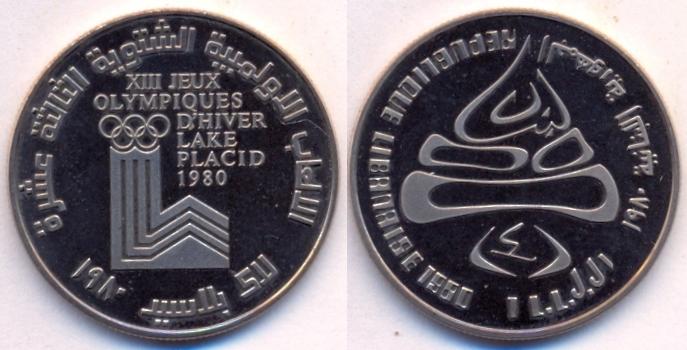 |
KM#32
1 Livre. Year:
1980.
Weight: 8.09g [8.00g].
Metal: Copper-Nickel.
Diameter:
27.00 mm. Edge:
Reeded.
Alignment: Medal.
Mint: N/A.
Obverse:
Arabic legend on top "الالعاب الاولمبية الشتوية الثالثة عشرة".
"XIII JEUX OLYMPIQUES D'HIVER LAKE PLACID 1980" in French and logo in
center. "ليك بلاسيد 1980" [Lake Placid 1980] at bottom.
Reverse:
"RÉPUBLIQUE LIBANAISE 1980" in French on left side anti-clockwise. "الجمهورية
اللبنانية 1980" in Arabic on right side clockwise. Value at bottom "1
L.L" "1
ل. ل.".
"Lubnan" in Arabic in center above two smaller and a rectangle boxes and
design (Stylized Flame). Mintage:
40,000.
Minted Years:
One year type. |
|
 |
|
KM#33
10 Livre. Year:
1980.
Weight: 19.19g [19.00g].
Metal: 0.500
silver. Diameter:
39.00 mm. Edge:
Reeded.
Alignment: Medal.
Mint: N/A.
Obverse:
Arabic legend on top "الالعاب الاولمبية الشتوية الثالثة عشرة".
"XIII JEUX OLYMPIQUES D'HIVER LAKE PLACID 1980" in French and logo in
center. "ليك بلاسيد 1980" [Lake Placid 1980] at bottom.
Reverse:
"RÉPUBLIQUE LIBANAISE 1980" in French on left side anti-clockwise. "الجمهورية
اللبنانية 1980" in Arabic on right side clockwise. Value at bottom "10
L.L" "10
ل. ل.".
"Lubnan" in Arabic in center above two smaller and a rectangle boxes and
design (Stylized Flame). Mintage:
20,000.
Minted Years:
One year type.
Note:
KM#34 400 Livres with the same above design
also exists in 8.00g 0.900 Gold. Mintage = 1,000 pieces. |
|
|
|
|
1981 |
|
|
|
 |
KM#30
1 Livre. Year:
1981.
Weight: 7.98g [8.00g].
Metal: Nickel.
Diameter:
27.00 mm. Edge:
Reeded.
Alignment:
Coin.
Mint: N/A.
Obverse:
Dates below
Cedar tree. "مصرف لبنان" [Masraf Lubnan] in Arabic on top and "BANQUE DU LIBAN" in French below the tree.
Reverse:
Value within wreath. Mintage:
N/A.
Minted Years:
1975, 1977, 1980 and 1981. |
|
 |
| KM#35
10 Livre. Year:
1981.
Weight: 25.00g.
Metal: Copper-Nickel.
Diameter:
31.50 mm. Edge:
Reeded.
Alignment: Coin.
Mint: N/A.
Obverse:
Dates below
Cedar tree. "مصرف لبنان" [Masraf Lubnan] in Arabic on top and "BANQUE DU LIBAN" in French below the tree.
Reverse:
"F.A.O" logo at the top. Man plowing a
farm with a pair of oxen. Sun radiant and mountains in the background.
Value written below the oxen. "JOURNÉE
MONDIALE DE L'ALIMENTATION" written in French on left side clockwise. "يوم
الأغذية العالمي" [yawm alaghdyh al'ealmy] in Arabic on right side
anti-clockwise. Star at bottom.
Mintage:
15,000.
Minted Years:
One year type.
Subject: World
Food Day - Celebrated on 16th October 1981 worldwide. |
|
|
|
|
1986 |
|
|
|
 |
KM#30a
1 Livre. Year:
1986.
Weight: 7.21g [7.20g].
Metal: Nickel.
Diameter:
27.00 mm. Edge:
Reeded.
Alignment:
Coin.
Mint: N/A.
Obverse:
Dates below
Cedar tree. "مصرف لبنان" [Masraf Lubnan] in Arabic on top and "BANQUE DU LIBAN" in French below the tree.
Reverse:
Value within wreath. Mintage:
N/A.
Minted Years:
One year type.
Note:
reduced weight than
pervious years (1975-1981) and having thinner numeral "1" on reverse
side. |
|
|
|
|
|
- Presidents
- Salim
Ahmed al-Hoss (1st
time - acting)..........23
Sep 1988 - 05 Nov 1989
- René Moawad......................................05
Nov 1989 - 22 Nov 1989
- Salim
Ahmed al-Hoss (2nd
time - acting)..........22
Nov 1989 - 24 Nov 1989
- Elias Hrawi......................................24
Nov 1989 - 23 Nov 1998
- In 1992, Hezbollah won ten
out of 128 seats in the Lebanese National Assembly. On 25 July 1993 Israel
launched Operation Accountability, known in Lebanon as the Seven-Day War, in
retaliation for attacks by both Hezbollah and the Popular Front for the
Liberation of Palestine - General Command which had killed five soldiers in
the security zone. Thousands of buildings were bombed, resulting in 120 dead
and 300,000 displaced civilians. Israeli forces also destroyed
infrastructure such as power stations and bridges. Hezbollah retaliated with
rocket attacks on Israeli villages, though inflicting significantly fewer
casualties.
On 11 April 1996 Israel
initiated Operation Grapes of Wrath, which Hezbollah calls the April War,
subsequent to Hezbollah launching missiles into Israel, which was in turn a
response to the killing of two Lebanese by an IDF missile, and the killing
of Lebanese boy by a road-side bomb. Israel conducted massive air raids and
extensive shelling in southern Lebanon. 106 Lebanese died in the shelling of
Qana, when a UN compound was hit in an Israeli shelling. The conflict ended
on 26 April 1996 with the Israeli-Lebanese Ceasefire Understanding in which
both Hezbollah and Israel agreed to forgo attacks on civilians. From 1985
through 2000, Israel continued to fund the South Lebanon Army.
- Émile
Geamil
Lahoud..............................24
Nov 1998 - 23 Nov 2007
- In January 2000, Hezbollah
assassinated the man responsible for day to day South Lebanon Army (SLA)
operations, Colonel Akel Hashem. The Israeli Air Force, in apparent
response, on 07 February struck Lebanon's civilian infrastructure, including
power stations at Baalbek, Deir Nbouh and Jambour. Eighteen people were
reported to have been injured. Following its declaration of intent to
implement UNSC Resolution 425 on 01 April 1998, and after the collapse of
the South Lebanon Army in the face of a Hezbollah onslaught, Israel declared
24 May 2000 that they would withdraw to their side of the UN designated
border, the Blue Line, 22 years after the resolution had been approved. The
South Lebanon Army's equipment and positions largely fell into the hands of
Hezbollah. Lebanon celebrates 25 May, Liberation Day, as a national holiday.
The Syrian presence ended in 2005, due to UN resolution 1559, after the
Rafiq Hariri assassination and the March 14 protests.
- On 12 July 2006, Hezbollah
launched a series of rocket attacks into Israeli towns and cities in
proximity to the Israeli Lebanese border. This was combined with a cross
border raid into Israeli territory where Hezbollah operatives killed three
Israeli soldiers and captured a further two. Hezbollah claims that the
objectives of the operation were to free Lebanese prisoners held in Israel.
Israel responded with airstrikes and a ground incursion into Lebanon aimed
at halting Hezbollah's rocket fire, reducing Hezbollah's military capacity
and rescuing the two abducted Israeli soldiers. The 34 day campaign caused
wide spread damage to Lebanon's infrastructure (including Beirut's airport).
Beirut's southern suburb was heavily damaged by Israeli airstrikes where
Hezbollah military infrastructure was deeply embedded among the civilian
population. The conflict officially ended on 14 August 2006, when the United
Nations Security Council issued resolution 1701 ordering a ceasefire between
Hezbollah and Israel.
- Fouad Siniora (acting)...........................24
Nov 2007 - 25 May 2008
- When Émile Lahoud's
presidential term ended in October 2007, the opposition refused to vote for
a successor unless a power-sharing deal was reached, leaving Lebanon without
a president. On 9 May 2008, Hezbollah and Amal forces, sparked by a
government declaration that Hezbollah's communications network was illegal,
seized western Beirut in Lebanon's worst internal violence since the 1975–90
civil war. Moreover, the violence, decried by the Lebanese government as an
attempted coup, threatened to escalate into another civil war. At least 62
people died in the resulting clashes between pro-government and opposition
militias. On 21 May 2008, after five days of negotiation under Arab League
mediation in Qatar, all major parties signed the Doha Agreement, which ended
the fighting. Under the accord, both sides agreed to elect former army head
Michel Suleiman president and establish a national unity government with a
veto share for the opposition. This ended 18 months of political paralysis.
The agreement was a victory for opposition forces, who received concessions
regarding the composition of the cabinet, Hezbollah's telecommunications
network, and the airport security chief, increasing their political clout.
- Michel
Suleiman..................................25 May 2008 - 24 May 2014
- In early January 2011, the
national unity government collapsed after all ten opposition ministers and
one presidential appointee resigned due to tensions stemming from the
Special Tribunal for Lebanon, which was expected to indict Hezbollah members
in the assassination of former prime minister Rafic Hariri. The collapse
plunged Lebanon into its worst political crisis since the 2008 fighting, and
indicated further political gains for the Hezbollah-led opposition
March 8 Alliance, which gained a parliamentary majority. The
parliament elected Najib Mikati, the 8 March candidate, Prime
Minister of Lebanon, making him responsible for forming a new government.
- Tammam Saeb Salam (acting).......................25
May 2014 - 31 Oct 2016
- Michel Naim Aoun.................................31
Oct 2016 - date
- He was elected president on
31 October 2016 on the 46th electoral session of the Lebanese parliament.
Lebanon had been without a head of state, after President Michel Suleiman
stepped down as president at the end of his term in May 2014, resulting in a
deadlock as the Parliament failed to elect a successor for 29 months and 45
previous parliamentary sessions did not achieve the necessary quorum for a
presidential ballot. On 19 December 2019, President Michel Aoun designates
Hassan Diab as prime minister. On 31 August
2020, President Michel Aoun designates Mustapha Adib to form a new
government. On 26 September 2020, Prime minister-designate Mustapha Adib
says he is unable to form a government.
|
|
|
|
Currency: Livre (Pound) |
|
Before the Lebanese Civil War, 1 U.S. dollar was worth 3
Livres (Pounds). Unofficially 1 U.S Dollar is equal and readily accepted as
1,500 Livres (Pound) since 1995. |
|
|
|
1995 |
|
|
|
 |
KM#38
100 Livres. Year:
1995.
Weight: 4.02g [4.00g].
Metal:
Copper-Zinc. Diameter:
22.50 mm. Edge:
Plain.
Thickness:
1.80 mm.
Alignment: Coin.
Mint: N/A.
Obverse:
"مصرف لبنان"
[Masraf Lubnan] in Arabic on top. Value super imposed on Cedar tree. Date
below Cedar tree.
Reverse:
Two banners above the value. "BANQUE DU
LIBAN" written in French below the value and date. Mintage:
N/A.
Minted Years: 1995, 1996
and 2000. Note:
Proof coin also exists. |
|
 |
KM#36
250 Livres. Year:
1995.
Weight: 5.01g [5.00g].
Metal:
Brass-Aluminum. Diameter:
23.00 mm. Edge:
Reeded.
Thickness:
1.82 mm.
Alignment: Coin.
Mint: N/A.
Obverse:
"مصرف لبنان"
[Masraf Lubnan] in Arabic on top. Value super imposed on Cedar tree. Date
below Cedar tree.
Reverse:
Date at the top. Large value "250" in
elliptical border design. "BANQUE DU LIBAN" written in French below the
value and date. Mintage:
N/A.
Minted Years: 1995,
1996, 2000, 2003, 2006, 2009, 2012, 2014 and 2018.
Note: Proof coin also exists. |
|
 |
KM#39
500 Livres. Year:
1995.
Weight: 5.99g [6.00g].
Metal: Nickel
Clad Steel. Diameter:
24.00 mm. Edge:
Plain.
Thickness: 2.05 mm.
Alignment: Coin.
Mint: N/A.
Obverse:
"مصرف لبنان"
[Masraf Lubnan] in Arabic on top. Value super imposed on Cedar tree in
center circle. Date
below Cedar tree.
Reverse:
Date at the top, Large value "500
LIVRES" and "BANQUE DU LIBAN" written in French below;
all within thick segmented circular border. Mintage:
N/A.
Minted Years: 1995, 1996, 2000, 2003,
2006 and 2009.
Note: Proof coin also exists. |
|
|
|
|
1996 |
|
|
|
 |
KM#37
50 Livres. Year:
1996.
Weight: 2.25g [2.29g].
Metal: Stainless
Steel. Diameter:
8-sided; 19.00 mm. Edge:
Plain.
Thickness:
1.15 mm.
Alignment: Coin.
Mint: N/A.
Obverse:
"مصرف لبنان"
[Masraf Lubnan] in Arabic on top. Value super imposed on Cedar tree in
center circle. Date below Cedar tree.
Reverse:
Date at the top. Value in center
circle. "BANQUE DU LIBAN" written in French below the value and date. Mintage:
N/A.
Minted Years: One year type. |
|
 |
KM#38
100 Livres. Year:
1996.
Weight: 3.98g [4.00g].
Metal:
Copper-Zinc. Diameter:
22.50 mm. Edge:
Plain.
Thickness:
1.80 mm.
Alignment: Coin.
Mint: N/A.
Obverse:
"مصرف لبنان"
[Masraf Lubnan] in Arabic on top. Value super imposed on Cedar tree. Date
below Cedar tree.
Reverse:
Two banners above the value. "BANQUE DU
LIBAN" written in French below the value and date. Mintage:
N/A.
Minted Years: 1995, 1996
and 2000. |
|
 |
KM#36
250 Livres. Year:
1996.
Weight: 4.92g [5.00g].
Metal:
Brass-Aluminum. Diameter:
23.00 mm. Edge:
Reeded.
Thickness:
1.82 mm.
Alignment: Coin.
Mint: N/A.
Obverse:
"مصرف لبنان"
[Masraf Lubnan] in Arabic on top. Value super imposed on Cedar tree. Date
below Cedar tree.
Reverse:
Date at the top. Large value "250" in
elliptical border design. "BANQUE DU LIBAN" written in French below the
value and date. Mintage:
N/A.
Minted Years: 1995,
1996, 2000, 2003, 2006, 2009, 2012, 2014 and 2018. |
|
 |
KM#39
500 Livres. Year:
1996.
Weight: 5.99g [6.00g].
Metal: Nickel
Clad Steel. Diameter:
24.00 mm. Edge:
Plain.
Thickness: 2.05 mm.
Alignment: Coin.
Mint: N/A.
Obverse:
"مصرف لبنان"
[Masraf Lubnan] in Arabic on top. Value super imposed on Cedar tree in
center circle. Date
below Cedar tree.
Reverse:
Date at the top, Large value "500
LIVRES" and "BANQUE DU LIBAN" written in French below;
all within thick segmented circular border. Mintage:
N/A.
Minted Years: 1995, 1996, 2000, 2003,
2006 and 2009. |
|
|
|
|
2000 |
|
|
|
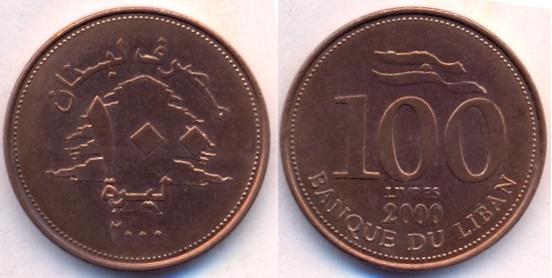 |
KM#38
100 Livres. Year:
2000.
Weight: 3.93g [4.00g].
Metal:
Copper-Zinc. Diameter:
22.50 mm. Edge:
Plain.
Thickness:
1.80 mm.
Alignment: Coin.
Mint: N/A.
Obverse:
"مصرف لبنان"
[Masraf Lubnan] in Arabic on top. Value super imposed on Cedar tree. Date
below Cedar tree.
Reverse:
Two banners above the value. "BANQUE DU
LIBAN" written in French below the value and date. Mintage:
N/A.
Minted Years: 1995, 1996
and 2000. |
|
 |
KM#36
250 Livres. Year:
2000.
Weight: 4.91g [5.00g].
Metal:
Brass-Aluminum. Diameter:
23.00 mm. Edge:
Reeded.
Thickness:
1.82 mm.
Alignment: Coin.
Mint: N/A.
Obverse:
"مصرف لبنان"
[Masraf Lubnan] in Arabic on top. Value super imposed on Cedar tree. Date
below Cedar tree.
Reverse:
Date at the top. Large value "250" in
elliptical border design. "BANQUE DU LIBAN" written in French below the
value and date. Mintage:
N/A.
Minted Years:
1995, 1996, 2000, 2003,
2006, 2009, 2012, 2014 and 2018. |
|
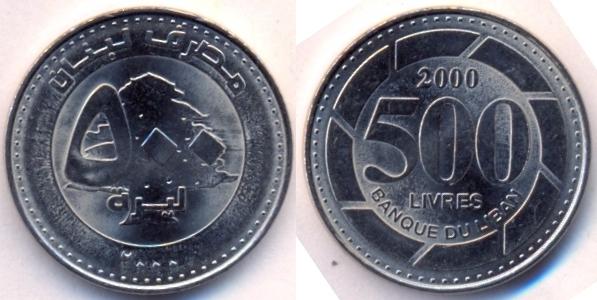 |
KM#39
500 Livres. Year:
2000.
Weight: 6.01g [6.00g].
Metal: Nickel
Clad Steel. Diameter:
24.00 mm. Edge:
Plain.
Thickness: 2.05 mm.
Alignment: Coin.
Mint: N/A.
Obverse:
"مصرف لبنان"
[Masraf Lubnan] in Arabic on top. Value super imposed on Cedar tree in
center circle. Date
below Cedar tree.
Reverse:
Date at the top, Large value "500
LIVRES" and "BANQUE DU LIBAN" written in French below;
all within thick segmented circular border. Mintage:
N/A.
Minted Years: 1995, 1996, 2000, 2003,
2006 and 2009. |
|
|
|
|
2002 |
|
|
|
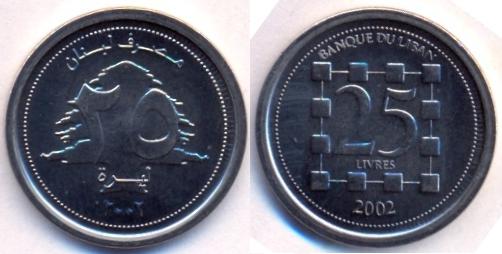 |
KM#40
25 Livres. Year:
2002.
Weight: 2.83g [2.85g].
Metal: Nickel
Clad Steel. Diameter:
20.00 mm. Edge:
Plain.
Alignment: Coin.
Mint: N/A.
Obverse:
"مصرف لبنان"
[Masraf Lubnan] in Arabic on top. Value super imposed on Cedar tree. Date
below Cedar tree.
Reverse:
"BANQUE DU LIBAN" written in French at
the top. Value written in decorated design square. Date below the
design. Mintage:
N/A.
Minted Years: One year type. |
|
|
|
|
2003 |
|
|
|
 |
KM#38a
100 Livres. Year:
2003.
Weight: 4.02g [4.00g].
Metal: Nickel
Clad Steel. Diameter:
22.50 mm. Edge:
Plain.
Thickness:
1.80 mm.
Alignment: Coin.
Mint: N/A.
Obverse:
"مصرف لبنان"
[Masraf Lubnan] in Arabic on top. Value super imposed on Cedar tree. Date
below Cedar tree.
Reverse:
Two banners above the value. "BANQUE DU
LIBAN" written in French below the value and date. Mintage:
N/A.
Minted Years: One year type. |
|
 |
KM#36
250 Livres. Year:
2003.
Weight: 4.97g [5.00g].
Metal:
Brass-Aluminum. Diameter:
23.00 mm. Edge:
Reeded.
Thickness:
1.82 mm.
Alignment: Coin.
Mint: N/A.
Obverse:
"مصرف لبنان"
[Masraf Lubnan] in Arabic on top. Value super imposed on Cedar tree. Date
below Cedar tree.
Reverse:
Date at the top. Large value "250" in
elliptical border design. "BANQUE DU LIBAN" written in French below the
value and date. Mintage:
N/A.
Minted Years: 1995,
1996, 2000, 2003, 2006, 2009, 2012, 2014 and 2018. |
|
 |
KM#39
500 Livres. Year:
2003.
Weight: 6.05g [6.00g].
Metal: Nickel
Clad Steel. Diameter:
24.00 mm. Edge:
Plain.
Thickness: 2.05 mm.
Alignment: Coin.
Mint: N/A.
Obverse:
"مصرف لبنان"
[Masraf Lubnan] in Arabic on top. Value super imposed on Cedar tree in
center circle. Date
below Cedar tree.
Reverse:
Date at the top, Large value "500
LIVRES" and "BANQUE DU LIBAN" written in French below;
all within thick segmented circular border. Mintage:
N/A.
Minted Years: 1995, 1996, 2000, 2003,
2006 and 2009. |
|
|
|
|
2006 |
|
|
|
 |
KM#41
50 Livres. Year:
2006.
Weight: 3.00g [3.00g].
Metal: Nickel
Clad Steel. Diameter:
21.00 mm. Edge:
Plain with security line in center.
Alignment: Coin.
Mint: N/A.
Obverse:
"مصرف لبنان"
[Masraf Lubnan] in Arabic on top. Value super imposed on Cedar tree in
center circle. Date below Cedar tree.
Reverse:
Date at the top. Value in center circle
with Dhow. "BANQUE DU LIBAN" written in French below the value and date. Mintage:
N/A.
Minted Years: One year type. |
|
 |
KM#38b
100 Livres. Year:
2006.
Weight: 3.96g [4.00g].
Metal:
Copper plated Steel. Diameter:
22.50 mm. Edge:
Plain.
Thickness:
1.80 mm.
Alignment: Coin.
Mint: N/A.
Obverse:
"مصرف لبنان"
[Masraf Lubnan] in Arabic on top. Value super imposed on Cedar tree. Date
below Cedar tree.
Reverse:
Two banners above the value. "BANQUE DU
LIBAN" written in French below the value and date. Mintage:
N/A.
Minted Years: 2006 and
2009. |
|
 |
KM#36
250 Livres. Year:
2006.
Weight: 4.97g [5.00g].
Metal:
Brass-Aluminum. Diameter:
23.00 mm. Edge:
Reeded.
Thickness:
1.82 mm.
Alignment: Coin.
Mint: N/A.
Obverse:
"مصرف لبنان"
[Masraf Lubnan] in Arabic on top. Value super imposed on Cedar tree. Date
below Cedar tree.
Reverse:
Date at the top. Large value "250" in
elliptical border design. "BANQUE DU LIBAN" written in French below the
value and date. Mintage:
N/A.
Minted Years: 1995,
1996, 2000, 2003, 2006, 2009, 2012, 2014 and 2018. |
|
 |
KM#39
500 Livres. Year:
2006.
Weight: 5.95g [6.00g].
Metal: Nickel
Clad Steel. Diameter:
24.00 mm. Edge:
Plain.
Thickness: 2.05 mm.
Alignment: Coin.
Mint: N/A.
Obverse:
"مصرف لبنان"
[Masraf Lubnan] in Arabic on top. Value super imposed on Cedar tree in
center circle. Date
below Cedar tree.
Reverse:
Date at the top, Large value "500
LIVRES" and "BANQUE DU LIBAN" written in French below;
all within thick segmented circular border. Mintage:
N/A.
Minted Years: 1995, 1996, 2000, 2003,
2006 and 2009. |
|
|
|
|
2009 |
|
|
|
 |
KM#38b
100 Livres. Year:
2009.
Weight: 3.95g [4.00g].
Metal:
Copper plated Steel. Diameter:
22.50 mm. Edge:
Plain.
Thickness:
1.80 mm.
Alignment: Coin.
Mint: N/A.
Obverse:
"مصرف لبنان"
[Masraf Lubnan] in Arabic on top. Value super imposed on Cedar tree. Date
below Cedar tree.
Reverse:
Two banners above the value. "BANQUE DU
LIBAN" written in French below the value and date. Mintage:
N/A.
Minted Years: 2006 and
2009. |
|
 |
KM#36
250 Livres. Year:
2009.
Weight: 4.98g [5.00g].
Metal:
Brass-Aluminum. Diameter:
23.00 mm. Edge:
Reeded.
Thickness:
1.82 mm.
Alignment: Coin.
Mint: N/A.
Obverse:
"مصرف لبنان"
[Masraf Lubnan] in Arabic on top. Value super imposed on Cedar tree. Date
below Cedar tree.
Reverse:
Date at the top. Large value "250" in
elliptical border design. "BANQUE DU LIBAN" written in French below the
value and date. Mintage:
N/A.
Minted Years: 1995,
1996, 2000, 2003, 2006, 2009, 2012, 2014 and 2018. |
|
 |
KM#39
500 Livres. Year:
2009.
Weight: 5.96g [6.00g].
Metal: Nickel
Clad Steel. Diameter:
24.00 mm. Edge:
Plain.
Thickness: 2.05 mm.
Alignment: Coin.
Mint: N/A.
Obverse:
"مصرف لبنان"
[Masraf Lubnan] in Arabic on top. Value super imposed on Cedar tree in
center circle. Date
below Cedar tree.
Reverse:
Date at the top, Large value "500
LIVRES" and "BANQUE DU LIBAN" written in French below;
all within thick segmented circular border. Mintage:
N/A.
Minted Years: 1995, 1996, 2000, 2003,
2006 and 2009. |
|
|
|
|
2012 |
|
|
|
 |
KM#36
250 Livres. Year:
2012.
Weight: 4.98g [5.00g].
Metal:
Brass-Aluminum. Diameter:
23.00 mm. Edge:
Reeded.
Thickness:
1.82 mm.
Alignment: Coin.
Mint: N/A.
Obverse:
"مصرف لبنان"
[Masraf Lubnan] in Arabic on top. Value super imposed on Cedar tree. Date
below Cedar tree.
Reverse:
Date at the top. Large value "250" in
elliptical border design. "BANQUE DU LIBAN" written in French below the
value and date. Mintage:
N/A.
Minted Years: 1995,
1996, 2000, 2003, 2006, 2009, 2012, 2014 and 2018. |
|
 |
KM#36a
250 Livres. Year:
2012.
Weight: 5.02g [5.00g].
Metal:
Brass-Aluminum / Rhodium plated cedar. Diameter:
23.00 mm. Edge:
Reeded.
Thickness:
1.82 mm.
Alignment: Coin.
Mint: N/A.
Obverse:
"مصرف لبنان"
[Masraf Lubnan] in Arabic on top. Value super imposed on Cedar tree. Date
below Cedar tree.
Reverse:
Date at the top. Large value "250" in
elliptical border design. "BANQUE DU LIBAN" written in French below the
value and date. Mintage:
N/A.
Minted Years: One
year type. |
|
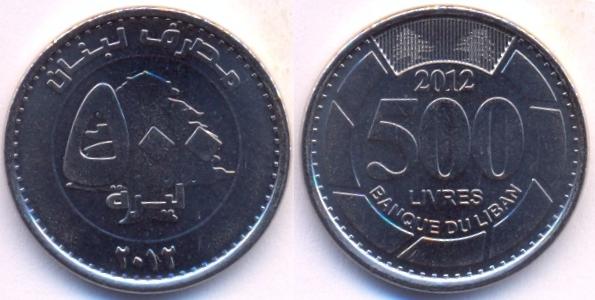 |
KM# 39a / Schön# 41.2 500 Livres. Year:
2012.
Weight: 6.01g [6.00g].
Metal: Nickel
Clad Steel. Diameter:
24.00 mm. Edge:
Plain.
Thickness: 2.05 mm.
Alignment: Coin.
Mint: N/A.
Obverse:
"مصرف لبنان"
[Masraf Lubnan] in Arabic on top. Value super imposed on Cedar tree in
center circle. Date
below Cedar tree.
Reverse:
Two hologram Cedar trees at the top and
Date below them. Large value "500 LIVRES" and "BANQUE DU LIBAN" written in French below;
all within thick segmented circular border. Mintage:
N/A.
Minted Years: 2012
and 2017. |
|
|
|
|
2014 |
|
|
|
 |
KM#36
250 Livres. Year:
2014.
Weight: 5.03g [5.00g].
Metal:
Brass-Aluminum. Diameter:
23.00 mm. Edge:
Reeded.
Thickness:
1.82 mm.
Alignment: Coin.
Mint: N/A.
Obverse:
"مصرف لبنان"
[Masraf Lubnan] in Arabic on top. Value super imposed on Cedar tree. Date
below Cedar tree.
Reverse:
Date at the top. Large value "250" in
elliptical border design. "BANQUE DU LIBAN" written in French below the
value and date. Mintage:
N/A.
Minted Years: 1995,
1996, 2000, 2003, 2006, 2009, 2012, 2014 and 2018. |
|
|
|
|
2017 |
|
|
|
 |
KM# 39a / Schön# 41.2 500 Livres. Year:
2012.
Weight: 6.01g [6.00g].
Metal: Nickel
Clad Steel. Diameter:
24.00 mm. Edge:
Plain.
Thickness: 2.05 mm.
Alignment: Coin.
Mint: N/A.
Obverse:
"مصرف لبنان"
[Masraf Lubnan] in Arabic on top. Value super imposed on Cedar tree in
center circle. Date
below Cedar tree.
Reverse:
Two hologram Cedar trees at the top and
Date below them. Large value "500 LIVRES" and "BANQUE DU LIBAN" written in French below;
all within thick segmented circular border. Mintage:
N/A.
Minted Years: 2012
and 2017. |
|
|
|
|
2018 |
|
|
|
 |
KM#36
250 Livres. Year:
2018.
Weight: 5.00g [5.00g].
Metal:
Brass-Aluminum. Diameter:
23.00 mm. Edge:
Reeded.
Thickness:
1.82 mm.
Alignment: Coin.
Mint: N/A.
Obverse:
"مصرف لبنان"
[Masraf Lubnan] in Arabic on top. Value super imposed on Cedar tree. Date
below Cedar tree.
Reverse:
Date at the top. Large value "250" in
elliptical border design. "BANQUE DU LIBAN" written in French below the
value and date. Mintage:
N/A.
Minted Years: 1995,
1996, 2000, 2003, 2006, 2009, 2012, 2014 and 2018. |
|
|
|
|
|
|
|
- President of the Administrative Council
- Habib Pacha Es-Saad..............................01
Oct 1918 - 07 Oct 1918
- President of the Representative Council
- Habib Pacha Es-Saad..............................08
May 1922 - 31 May 1926
- Prime ministers
- From 23 May 1926 According to the National Compact
the President of the Republic is a Maronite Christian elected for six years
from the Parliament; he is not immediately re-eligible. The Prime minister
is a Sunni Muslim. The Compact was renewed 12 Aug 1989.
- Auguste Adib Pacha (1st
time)....................31
May 1926 - 05 May 1927
- Béchara Khalil El-Khoury.........................05
May 1927 - 10 Aug 1928
- Habib Pacha Es-Saad..............................10
Aug 1928 - 09 May 1929
- Béchara Khalil El-Khoury
(2nd time)..............09
May 1929 - 11 Oct 1929
- Émile Eddé.......................................11
Oct 1929 - 25 Mar 1930
- Auguste Adib Pacha...............................25
Mar 1930 - 09 Mar 1932
- Charles Dabbas...................................09
Mar 1932 - 29 Jan 1934
- Abdullah Bayhum (1st
time - acting)..............29
Mar 1934 - 30 Jan 1936
- Ayub Thabit (1st
time - acting)..................30
Jan 1936 - 05 Jan 1937
- Khayreddin al-Ahdab..............................05
Jan 1937 - 18 Mar 1938
- Amir Khalid Chehab (1st
time)....................18
Mar 1938 - 24 Oct 1938
- Abdullah Aref al-Yafi
(1st time).................24
Oct 1938 - 21 Sep 1939
- Abdullah Bayhum (2nd
time).......................21
Sep 1939 - 04 Apr 1941
- Alfred Georges
Naccache..........................07 Apr 1941 - 26 Nov 1941
- Ahmed Daouk (1st
time)...........................01
Dec 1941 - 26 Jul 1942
- Sami as-Solh (1st
time)..........................26
Jul 1942 - 22 Mar 1943
- Ayub Thabit (2nd
time - acting)..................22
Mar 1943 - 21 Jul 1943
- Petro Trad.......................................01
Aug 1943 - 25 Sep 1943
- Riad as-Solh (1st
time)..........................25
Sep 1943 - 10 Jan 1945
- Abdul Hamid Karami...............................10
Jan 1945 - 20 Aug 1945
- Sami as-Solh (2nd
time)..........................23
Aug 1945 - 22 May 1946
- Saadi al-Munla...................................22
May 1946 - 14 Dec 1946
- Riad as-Solh (2nd
time)..........................14
Dec 1946 - 14 Feb 1951
- Hussein al-Oweini (1st
time).....................14
Feb 1951 - 07 Apr 1951
- Abdullah Aref al-Yafi
(2nd time).................07
Apr 1951 - 11 Feb 1952
- Sami as-Solh (3rd
time)..........................11
Feb 1952 - 09 Sep 1952
- Nazim al-Akkari..................................10
Sep 1952 - 14 Sep 1952
- Saeb Salam (1st
time)............................14
Sep 1952 - 18 Sep 1952
- Abdullah Aref al-Yafi
(3rd time).................24
Sep 1952 - 30 Sep 1952
- Khalid Chehab (2nd
time).........................01
Oct 1952 - 01 May 1953
- Saeb Salam (2nd
time)............................01
May 1953 - 13 Aug 1953
- Abdullah Aref al-Yafi
(4th time).................16
Aug 1953 - 16 Sep 1954
- Sami as-Solh (4th
time)..........................16
Sep 1954 - 19 Sep 1955
- Rashid Karami (1st
time).........................19
Sep 1955 - 20 Mar 1956
- Abdullah Aref al-Yafi
(5th time).................20
Mar 1956 - 18 Nov 1956
- Sami as-Solh (5th
time)..........................27
Nov 1956 - 20 Sep 1958
- Khalid al-Hibri (acting).........................20
Sep 1958 - 24 Sep 1958
- Rashid Karami (2nd
time).........................24
Sep 1958 - 14 May 1960
- Ahmed Daouk (2nd
time)...........................14
May 1960 - 01 Aug 1960
- Saeb Salam (3rd
time)............................02
Aug 1960 - 31 Oct 1961
- Rashid Karami (3rd
time).........................31
Oct 1961 - 20 Feb 1964
- Hussein al-Oweini (2nd
time).....................20
Feb 1964 - 25 Jul 1965
- Rashid Karami (4th
time).........................25
Jul 1965 - 09 Apr 1966
- Abdullah Aref al-Yafi
(6th time).................09
Apr 1966 - 02 Dec 1966
- Rashid Karami (5th
time).........................07
Dec 1966 - 08 Feb 1968
- Abdullah Aref al-Yafi
(7th time).................08
Feb 1968 - 15 Jan 1969
- Rashid Karami (6th
time).........................15
Jan 1969 - 13 Oct 1970
- Saeb Salam (4th
time)............................13
Oct 1970 - 25 Apr 1973
- Amin
al-Hafez....................................25 Apr 1973 - 21 Jun 1973
- Takieddin as-Solh (1st
time).....................21
Jun 1973 - 31 Oct 1974
- Rashid as-Solh (1st
time)........................31
Oct 1974 - 24 May 1975
- Nureddin Rifai...................................24
May 1975 - 30 Jun 1975
- Rashid Karami (7th
time).........................01
Jul 1975 - 08 Dec 1976
- Selim Ahmed al-Hoss (1st
time)...................08
Dec 1976 - 20 Jul 1980
- Takieddin as-Solh (2nd
time).....................20
Jul 1980 - 25 Oct 1980
- Shafiq al-Wazzan.................................25
Oct 1980 - 30 Apr 1984
- Rashid Karami (8th
time).........................30
Apr 1984 - 01 Jun 1987
- Selim Ahmed al-Hoss (2nd
time)...................01
Jun 1987 - 24 Dec 1990
- Michel Naïm Aoun.................................23
Sep 1988 - 13 Oct 1990
- General Michel Naïm Aoun chaired a military
cabinet in dissidence from 23 Sep 1988 - 13 Oct 1990 and also claimed to be
the acting president.
- Omar Karami (1st
time)...........................24
Dec 1990 - 13 May 1992
- Rashid as-Solh (2nd
time)........................13
May 1992 - 31 Oct 1992
- Rafiq Bahaeddine
al-Hariri (1st time)............31
Oct 1992 - 06 Dec 1998
- Sélim Ahmed al-Hoss (3rd
time)...................06
Dec 1998 - 23 Oct 2000
- Rafiq Bahaeddine
al-Hariri (2nd time)............23
Oct 2000 - 21 Oct 2004
- Omar Karami (2nd
time)...........................21
Oct 2004 - 19 Apr 2005
- Najib Azmi Mikati (1st
time).....................19
Apr 2005 - 19 Jul 2005
- Fouad Siniora....................................19
Jul 2005 - 09 Nov 2009
- Saad El-Din Rafik Al-Hariri (1st
time)...........09 Nov 2009 - 13 Jun 2011
- Najib Azmi Mikati (2nd
time).....................13
Jun 2011 - 15 Feb 2014
- On 22 March 2013, Mikati resigned from office and
the Lebanese president accepted his resignation on 23 March 2013. Mikati
therefore has become acting Prime Minister since 23 March 2013. On 06 April
2013, Tammam Saeb Salam was tasked to form a new government.
- Tammam
Saeb Salam................................15 Feb 2014 - 18 Dec 2016
- Saad El-Din Rafik Al-Hariri (2nd
time)...........18
Dec 2016 - 21 Jan 2020
- He is the second son of former Lebanese Prime
Minister Rafic Hariri, who was assassinated in 2005. Hariri has also been
the leader of the Future Movement party since 2005. He is seen as the
strongest figurehead of the "March 14 Alliance". After three years living
overseas, he returned to Lebanon on 08 August 2014 and he was designated
Prime Minister on 03 November 2016. Hariri's surprise resignation on 04
November 2017 in a televised statement from Saudi Arabia, was widely seen as
part of the Iran–Saudi Arabia proxy conflict in Lebanon and triggered a
dispute between Lebanon and Saudi Arabia. Hariri tendered his resignation
from office, citing Iran’s and Hezbollah's political over-extension in the
Middle East region and fears of assassination. Iran vehemently rejected Saad
Hariri's remarks and called his resignation part of a plot by the United
States, Israel, and Saudi Arabia to heighten Middle Eastern tensions. He
rescinds his resignation on 05 December 2017. On 31 January 2019, a new
government is named under Prime Minister Saad Hariri, including Elias Bou
Saab as defense minister and Raya al-Hassan as interior minister; Foreign
Minister Gebran Bassil and Finance Minister Ali Hassan Khalil keep their
posts. On 15 February 2019, Saad Hariri's government wins a confidence vote
in parliament (111-6). On 29 October, Prime Minister Saad Hariri resigns. On
30 October, President Michel Aoun asks the cabinet to continue in a
caretaker role until a new government is formed.
- Hassan Diab......................................21
Jan 2020 - date
- On 21 January 2020, the new government led by
Hassan Diab is appointed with Nassif Hitti as foreign minister, Zeina Akar
as defense minister, Mohammad Fahmi as interior minister, and Ghazi Wazni as
finance minister. Diab served as the Lebanese Minister of Education from
2011 to 2014, under President Michel Suleiman. On 11 February 2020, Prime
Minister Hassan Diab's government wins a confidence vote in parliament
(63-20, 44 absent). On 03 August 2020, Foreign Minister Nassif Hitti resigns
and Charbel Wehbe is appointed to replace him. On 10 August 2002, Finance
Minister Ghazi Wazni resigns. Later in the day Prime Minister Hassan Diab
announces the resignation of his government in the wake of the explosions in
Beirut, (Ammonium nitrate explosion on 04 August 2020 at 18:08:18) mounting
political pressure that was exacerbated by the event, that killed at least
200 people. On 22 October 2020, President Michel Aoun designates Saad Hariri
as prime minister.
|
|
|
|
|
|
Southern Lebanon ("Free Republic of Lebanon")
|
|
|
|
30
Oct 1948 - 23 Mar 1949 Israeli troops occupy 13 villages in a strip of land
around
(and including) the Lebanese town of Houla near
the
Israeli-Lebanese border as part of the operation
capturing
Galilee in the 1948-1949 Arab-Israeli War.
14 Mar 1978 First Israeli invasion, resulting in the creation of an
occupied zone run by an Israeli allied Christian
militia
referred to as the "Free Lebanon Army."
19 Mar 1978 UNIFIL established, first troops arrive in Lebanon on
23 March 1978.
13 Jun 1978 Israel withdraws (most of) its troops from southern Lebanon.
18 Apr 1979 Hadad declares independence (Free Republic of Lebanon).
May 1980 Free Lebanon Army renamed as the Army of South Lebanon (South
Lebanese Army [SLA]).
06 Jun 1982 Second Israeli invasion; South Lebanese security zone formally
created by Israel. The pro-Israeli Christian Army
of South
Lebanon (South Lebanese Army [SLA]) established.
1983 – 1985 Israel withdraws its troops to a (South Lebanese) security
zone in southern Lebanon that was formally
established by
Israel, the Zone is patrolled by the IDF and SLA.
01 Jun 1999 Israel withdraws from Jezzine.
22 May 2000 Israel evacuates southern Lebanon, the SLA dissolves.
22
Jul 2006 - 01 Oct 2006 Third Israeli invasion, resulting in the capture of
number of villages in southern Lebanon. |
|
|
- Commanders of the Army of South
Lebanon (also heads of government of "Free Lebanon") -
Capital: Marjayoun.
- Saad
Haddad......................................18 Apr 1979 - 15 Jan 1984 d.
1984
- Antoine Lahad....................................15
Jan 1984 - 23 May 2000 d. 2015
- Executive Director of Government of
Free Lebanon in Exile
- Nagi N. Najjar..........................................2000
- date
|
|
|
- Israeli Commanders of the Lebanon
Liaison Unit
- Yoram Hamizrachi.......................................1978
- 1980 d. 2010
- Ephraim Sneh.......................................Nov
1981 - Dec 1982
- Meir Dagan (1st
time)..................................1980
- 1981 d. 2016
- David Maimon..................................................1982
d. 2010
- Meir Dagan (2nd
time)..............................Dec
1982 - Apr 1984
- Shlomo Ilya........................................Apr
1984 - Apr 1985
- Daniel
Rothschild..................................Apr 1985 - Aug 1986
- David Agmon........................................Aug
1986 - Jun 1988
- Zeev Zakharin......................................Jun
1988 - Feb 1991
- Micha Tamir........................................Feb
1991 - Oct 1992
- Gabi
Ashkenazi.....................................Oct 1992 - Jul 1994
- Giora Inbar........................................Jul
1994 - Jun 199
- Eli Amitai (1st
time)..............................Jun
1996 - Feb 1998
- Erez
Gerstein......................................Feb 1998 - 28 Feb 1999 d. 1999
- Eli Amitai (acting
- 2nd time)................................1999
- Benny Gantz............................................1999
- May 2000
|
|
|
-
Israeli Military Governors
(commanders of Israel Northern Command)
-
Avigdor Ben Gal.........................................1977 - 1981
-
Amir Drori..............................................1981 - 1983
-
Uri Or..................................................1983 - 1986
-
Yossi Peled.............................................1986 - 1991
-
Yitzhak Mordechai.......................................1991 - 1994
-
Amiram Levin............................................1994 - 1998
-
Gabi Ashkenazi..........................................1998 - 2000
-
Udi Adam.........................................22 Jul 2006 - 01 Oct 2006
|
|
|
-
United Nations
Interim Force in Lebanon (UNIFIL) -
Headquarters: Naqoura
- Commanders of the United Nations Interim Force
in Lebanon (UNIFIL)
-
Emmanuel A. Erskine (Ghana).....................23
Mar 1978 - Feb 1981
-
William Callaghan (Ireland)........................Feb
1981 - May 1986 d. 2015
-
Johan Gustav Hägglund (Finland)....................Jun
1986 - Jun 1988
-
Lars Eric Wahlgren (Sweden)........................Jul
1988 - Feb 1993 d. 1999
-
Trond Furuhovde (Norway)........................23
Feb 1993 - 01 Apr 1995 d. 2006
-
Stanisław Franciszek Woźniak (Poland)...........01
Apr 1995 - 30 Sep 1997
-
Jioji "George" Konousi Konrote (Fiji)...........01
Oct 1997 - 30 Sep 1999
-
James Sreenan (Ireland)(acting).................30
Sep 1999 - 01 Dec 1999
-
Seth Kofi Obeng (Ghana).........................01
Dec 1999 - 15 May 2001
-
Ganesan Athmanathan (India)(acting).............15
May 2001 - 17 Aug 2001
-
Lalit Mohan Tewari (India)......................17
Aug 2001 - 17 Feb 2004 d. 2004
-
Alain Pellegrini (France).......................17
Feb 2004 - 17 Feb 2007
-
Claudio Graziano (Italy)........................17
Feb 2007 - 28 Jan 2010
-
Alberto Asarta Cuevas (Spain)...................28
Jan 2010 - 28 Jan 2012
-
Paolo Serra (Italy).............................28
Jan 2012 - 24 Jul 2014
-
Luciano Portolano (Italy).......................24
Jul 2014 - 19 Jul 2016
-
Michael Beary (Ireland).........................19
Jul 2016 - 07 Aug 2018
-
Stefano Del Col (Italy).........................07
Aug 2018 - date
|
|
|
|
|
| |
|
|
|
|
| Countries
/ Territories |
| |
|
Chiefa Coins | |
|































.jpg)
_Rotated.jpg)
.jpg)
_Rotated.jpg)
.jpg)
_Rotated.jpg)







































































